Yamaha P-200, P200E User Manual
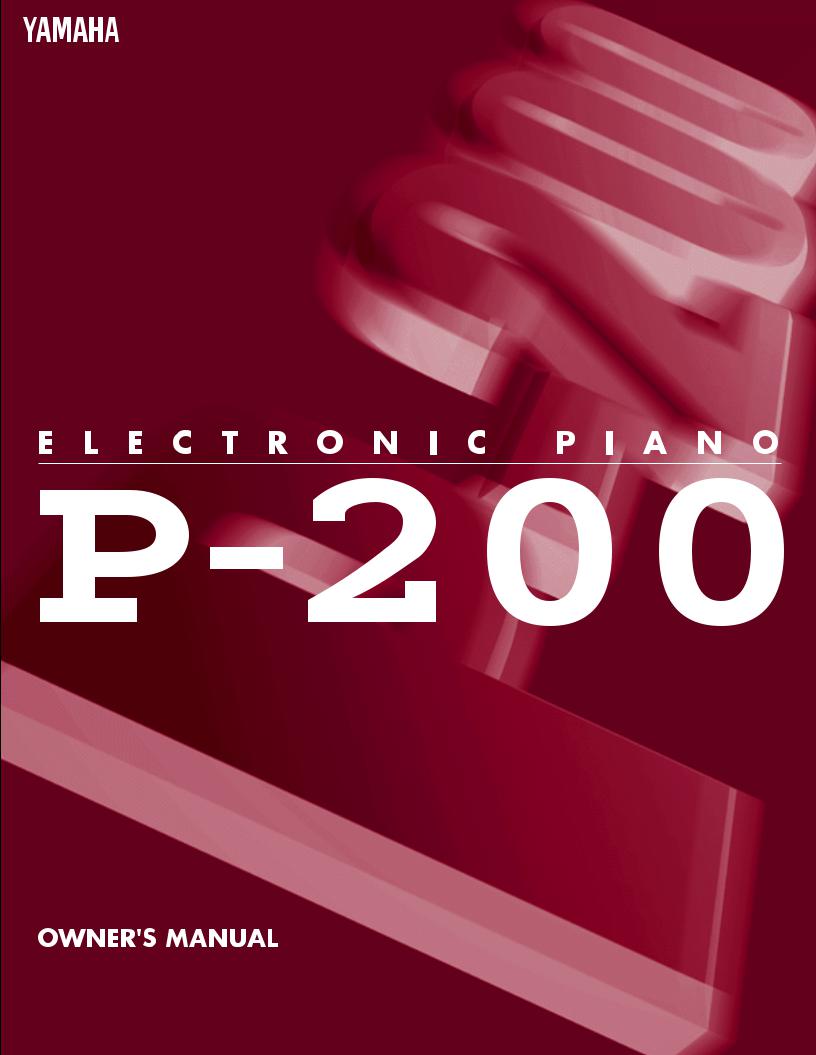
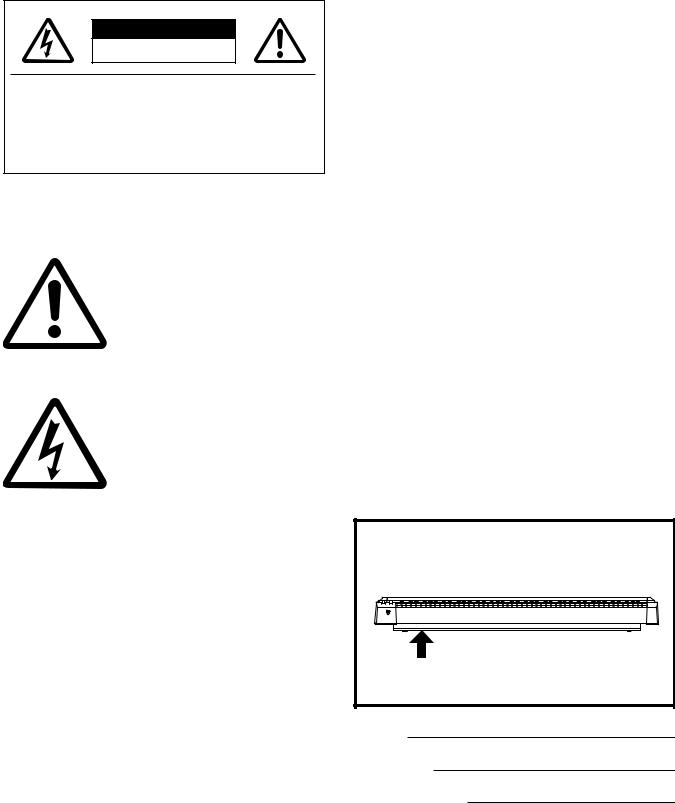
SPECIAL MESSAGE SECTION
PRODUCT SAFETY MARKINGS: Yamaha electronic products may have either labels similar to the graphics shown below or molded / stamped facsimiles of these graphics on the enclosure. The explanation of these graphics appears on this page.
Please observe all cautions indicated on this page and those indicated in the safety instruction section.
CAUTION |
RISK OF ELECTRIC SHOCK. |
DO NOT OPEN |
CAUTION: TO REDUCE THE RISK OF |
ELECTRIC SHOCK, DO NOT REMOVE |
COVER (OR BACK). NO USER-SERVICEABLE |
PARTS INSIDE. REFER SERVICING TO |
QUALIFIED SERVICE PERSONNEL. |
See the name plate for graphic symbol markings.
The exclamation point within the equilateral triangle is intended to alert the user to the present of important o p e r a t i n g a n d m a i n t e n a n c e (servicing) instructions in the literature accompanying the product.
The lightning flash with arrowhead symbol within the equilateral triangle is intended to alert the user to the presence of uninsulated "dangerous voltage" within the product's enclosure that may be of sufficient magnitude to constitute a risk of electrical shock.
IMPORTANT NOTICE: All Yamaha electronic products are tested and approved by an independent safety testing laboratory in order that you may be sure that when it is properly installed and used in its normal and customary manner, all foreseeable risks have been eliminated. DO NOT modify this unit or commission others to do so unless specifically authorized by Yamaha.
Product performance and/or safety standards may be diminished. Claims filed under the expressed warranty may be denied if the unit is/has been modified. Implied warranties may also be affected.
SPECIFICATIONS SUBJECT TO CHANGE: The information contained in this manual is believed to be correct at the time of printing. However, Yamaha reserves the right to change or modify any of the specifications without notice or obligation to update existing units.
ENVIRONMENTAL ISSUES: Yamaha strives to produce products that are both user safe and environmentally friendly.
We sincerely believe that our products and the production methods used to produce them, meet these goals. In keeping with both the letter and the spirit of the law, we want you to be aware of the following:
BATTERY NOTICE : This product MAY contain a small nonrechargeable battery which (if applicable) is soldered in place. The average life span of this type of battery is approximately five years. When replacement becomes necessary, contact a qualified service representative to perform the replacement.
WARNING: Do not attempt to recharge, disassemble, or incinerate this type of battery. Keep all batteries away from children. Dispose of used batteries promptly and as regulated by applicable laws. Note: In some areas, the servicer is required by law to return the defective parts. However, you do have the option of having the servicer dispose of these parts for you.
DISPOSAL NOTICE: Should this product become damaged beyond repair, or for some reason its useful life is considered to be at an end, please observe all local, state, and federal regulations that relate to the disposal of products that contain lead, batteries, plastics, etc.
NOTICE: Service charges incurred due to lack of knowledge relating to how a function or effect works (when the unit is operating as designed) are not covered by the manufacture's warranty, and are therefore the owner's responsibility.
Please study this manual carefully and consult your dealer before requesting service.
NAME PLATE LOCATION: The graphic below indicates the location of the name plate. The model number, serial number, power requirements, etc., are located on this plate. You should record the model number, serial number, and the date of purchase in the spaces provided below and retain this manual as a permanent record of your purchase.
Model |
Serial No.
Purchase Date
92-469-
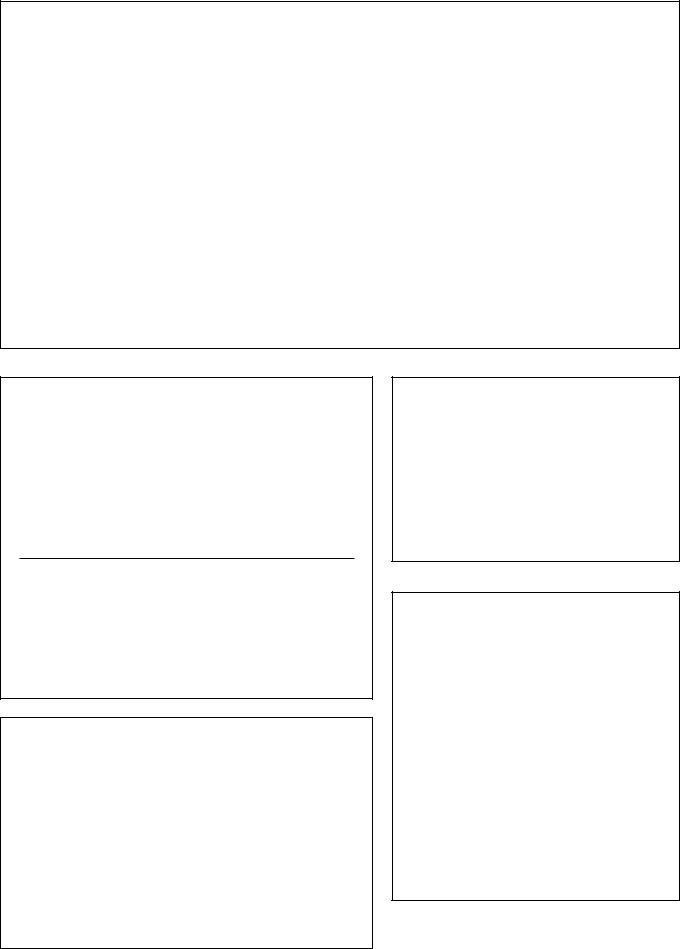
FCC INFORMATION (U.S.A)
1. IMPORTANT NOTICE: DO NOT MODIFY THIS UNIT!
This product, when installed as indicated in the instructions contained in this manual, meets FCC requirements. Modifications not expressly approved by Yamaha may void your authority, granted by the FCC, to use the product.
2. IMPORTANT: When connecting this product to accessories and/or another product use only high quality shielded cables.
Cable/s supplied with this product MUST be used. Follow all installation instructions. Failure to follow instructions could void your FCC authorization to use this product in the USA.
3. NOTE: This product has been tested and found to comply with the requirements listed in FCC Regulations, Part 15 for Class "B" digital devices. Compliance with these requirements provides a reasonable level of assurance that your use of this product in a residential environment will not result in harmful interference with other electronic devices. This equipment generates/uses radio frequencies and, if not installed and used according to the instructions found in the user's manual, may cause interference harmful to the operation of other electronic devices. Compliance with FCC regulations does not guarantee that interference will not occur in all installations. If this product is found to be the source of interference, which can be determined by turning the unit "OFF" and "ON", please try to eliminate the problem by using one of the following measures :
Relocate either this product or the device that is being affected by the interference.
Utilize power outlets that are on different branch (circuit breaker or fuse) circuits or install AC line filter/s.
In the case of radio or TV interference, relocate/reorient the antenna.
If the antenna lead-in is 300 ohm ribbon lead, change the lead-in to co-axial type cable.
If these corrective measures do not produce satisfactory results, please contact the your local retailer authorized to distribute this type of product.
If you can not locate the appropriate retailer, please contact Yamaha Corporation of America, Electronic Service Division, 6600 Orangethorpe Ave, Buena Park, CA 90620.
The above statements apply ONLY to those products distributed by Yamaha Corporation of America or its subsidiaries.
CANADA
THIS DIGITAL APPARATUS DOES NOT EXCEED THE "CLASS B" LIMITS FOR RADIO NOISE EMISSIONS FROM DIGITAL APPARATUS SET OUT IN THE RADIO INTERFERENCE REGULATION OF THE CANADIAN DEPARTMENT OF COMMUNICATIONS.
LE PRESENT APPAREIL NUMERIQUE N'EMET PAS DE BRUITS RADIOELECTRIQUES DEPASSANT LES LIMITES APPLICABLES AUX APPAREILS NUMERIQUES DE LA "CLASSE B" PRESCRITES DANS LE REGLEMENT SUR LE BROUILLAGE RADIOELECTRIQUE EDICTE PAR LE MINISTERE DES COMMUNICATIONS DU CANADA.
CAUTION: TO PREVENT ELECTRIC SHOCK, MATCH WIDE BLADE OF PLUG TO WIDE SLOT, FULLY INSERT.
ATTENTION: POUR ÉVITER LES CHOCS ÉLECTRIQUES, INTRODUIRE LA LAME LA PLUS LARGE DE LA FICHE DANS LA BORNE CORRESPONDANTE DE LA PRISE ET POUSSER JUSQU'AU FOND.
•This applies only to products distributed by Yamaha Canada Music LTD.
•Ceci ne s'applique qu'aux produits distribués par Yamaha Canada Music LTD.
IMPORTANT NOTICE FOR THE UNITED KINGDOM
Connecting the plug and Cord
IMPORTANT: THE WIRES IN MAINS LEAD ARE COLOURED IN ACCORDANCE WITH THE FOLLOWING CODE:
BLUE : NEUTRAL BROWN : LIVE
As the colours of the wires in the mains lead of this apparatus may not correspond with the coloured markings identifying the terminals in your plug, proceed as follows:
The wire which is coloured BLUE must be connected to the terminal which is marked with the letter N or coloured BLACK.
The wire which is coloured BROWN must be connected to the terminal which is marked with the letter L or coloured RED.
Making sure that neither core is connected to the earth terminal of the three pin plug.
Litiumbatteri!
Bör endast bytas av servicepersonal.
Explosionsfara vid felaktig hantering.
VAROITUS!
Lithiumparisto, Räjähdysvaara.
Pariston saa vaihtaa ainoastaan alan ammattimies.
ADVARSEL!
Lithiumbatteri!
Eksplosionsfare. Udskiftning må kun foretages af en sagkyndig, - og som beskrevet i servicemanualen.
NEDERLAND / THE NETHERLANDS
•Dit apparaat bevat een lithium batterij voor geheugen back-up.
•This apparatus contains a lithium battery for memory back-up.
•Raadpleeg uw leverancier over de verwijdering van de batterij op het moment dat u het apparaat ann het einde van de levensduur afdankt of de volgende Yamaha Service Afdeiing:
Yamaha Music Nederland Service Afdeiing Kanaalweg 18-G, 3526 KL UTRECHT
Tel. 030-2828425
•For the removal of the battery at the moment of the disposal at the end of the service life please consult your retailer or Yamaha Service Center as follows:
Yamaha Music Nederland Service Center Address : Kanaalweg 18-G, 3526 KL UTRECHT
Tel : 030-2828425
•Gooi de batterij niet weg, maar lever hem in als KCA.
•Do not throw away the battery. Instead, hand it in as small chemical waste.
IMPORTANTSAFETYINSTRUCTIONS
INFORMATION RELATING TO PERSONAL INJURY, ELECTRICAL SHOCK, AND FIRE HAZARD
POSSIBILITIES HAS BEEN INCLUDED IN THIS LIST.
WARNING- When using any electrical or electronic product, basic precautions should always be followed. These precautions include, but are not limited to, the following:
1. Read all Safety Instructions, Installation Instructions, Special Message Section items, and any Assembly Instructions found in this manual BEFORE making any connections, including connections to the main supply.
2. Main Power Supply Verification: Yamaha products are manufactured specifically for the supply voltage in the area where they are to be sold. If you should move, or if any doubt exists about the supply voltage in your area, please contact your dealer for supply voltage verification and (if applicable) instructions. The required supply voltage is printed on the name plate. For name plate location, please refer to the graphic found in the Special Message Section of this manual.
3. This product may be equipped with a polarized plug (one blade wider than the other ). If you are unable to insert the plug into the outlet, turn the plug over and try again. If the problem persists, contact an electrician to have the obsolete outlet replaced. DO NOT defeat the safety purpose of the plug.
4. Some electronic products utilize external power supplies or adapters. DO NOT connect this type of product to any power supply or adapter other than one described in the owners manual, on the name plate, or specifically recommended by Yamaha.
5. WARNING: Do not place this product or any other objects on the power cord or place it in a position where anyone could walk on, trip over, or roll anything over power or connecting cords of any kind. The use of an extension cord is not recommended! IF you must use an extension cord, the minimum wire size for a 25' cord (or less) is 18 AWG. NOTE: The smaller the AWG number,the larger the current handling capacity. For longer extension cords, consult a local electrician.
6. Ventilation: Electronic products, unless specifically designed for enclosed installations, should be placed in locations that do not interfere with proper ventilation. If instructions for enclosed installations are not provided,it must be assumed that unobstructed ventilation is required.
7. Temperature considerations: Electronic products should be installed in locations that do not significantly contribute to their operating temperature. Placement of this product close to heat sources such as; radiators, heat registers and other devices that produce heat should be avoided.
8. This product was NOT designed for use in wet/damp locations and should not be used near water or exposed to rain. Examples of wet /damp locations are; near a swimming pool, spa, tub, sink, or wet basement.
9. This product should be used only with the components supplied or; a cart ,rack, or stand that is recommended by the manufacturer . If a cart, rack, or stand is used, please observe all safety markings and instructions that accompany the accessory product.
10. The power supply cord (plug) should be disconnected from the outlet when electronic products are to be left unused for extended periods of time. Cords should also be disconnected when there is a high probability of lightening and/or electrical storm activity.
11. Care should be taken that objects do not fall and liquids are not spilled into the enclosure through any openings that may exist.
12. Electrical/electronic products should be serviced by a qualified service person when:
a.The power supply cord has been damaged; or
b.Objects have fallen, been inserted, or liquids have been spilled into the enclosure through openings; or
c.The product has been exposed to rain; or
d.The product does not operate, exhibits a marked change in performance; or
e.The product has been dropped, or the enclosure of the product has been damaged.
13. Do not attempt to service this product beyond that described in the user-maintenance instructions. All other servicing should be referred to qualified service personnel.
14. This product, either alone or in combination with an amplifier and headphones or speaker/s, may be capable of producing sound levels that could cause permanent hearing loss. DO NOT operate for a long period of time at a high volume level or at a level that is uncomfortable. If you experience any hearing loss or ringing in the ears, you should consult an audiologist.
IMPORTANT: The louder the sound, the shorter the time period before damage occurs.
15. Some Yamaha products may have benches and/or accessory mounting fixtures that are either supplied as a part of the product or as optional accessories. Some of these items are designed to be dealer assembled or installed. Please make sure that benches are stable and any optional fixtures (where applicable) are well secured BEFORE using. Benches supplied by Yamaha are designed for seating only. No other uses are recommended.
PLEASE KEEP THIS MANUAL
92-469-2
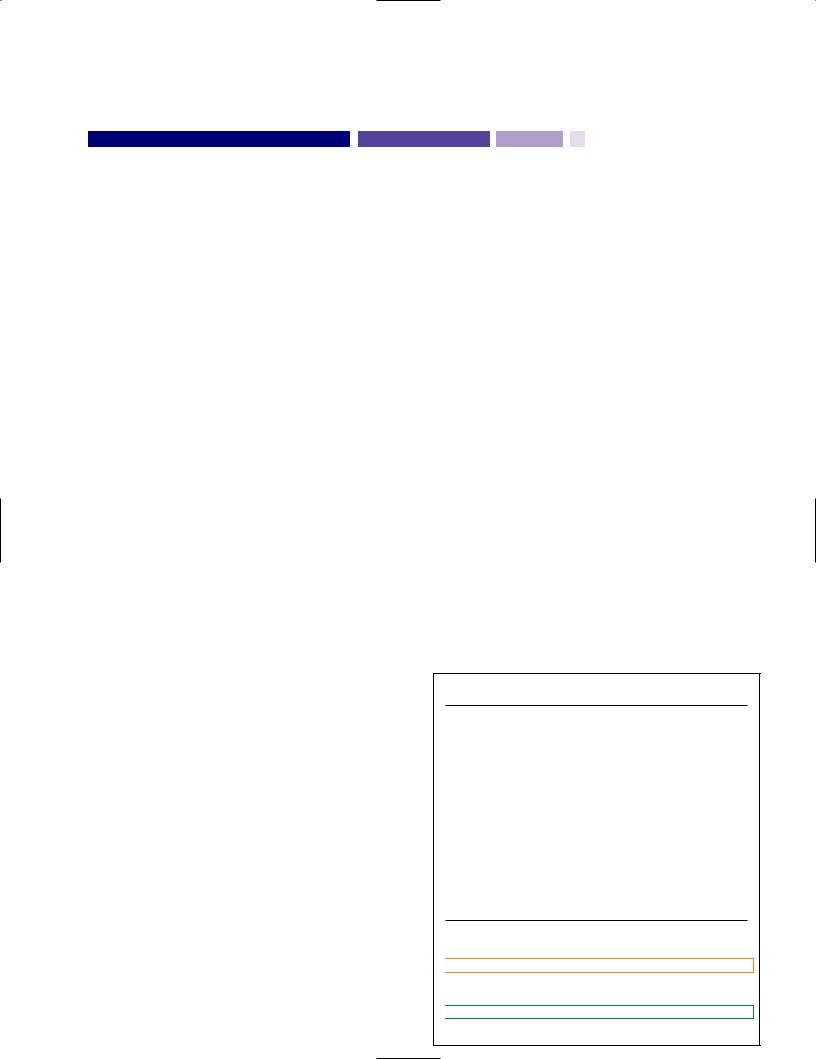
INTRODUCTION
Congratulations! …and thank you for purchasing the Yamaha P-200. The P-200 is a high-performance electronic piano with full-scale, weighted action keyboard, a selection of high quality piano and other useful instrument voices, and versatile performance and other advanced features which make it ideal for professional stage and studio applications, as well as for home entertainment and music study use. The P-200’s main features include:
■ High quality AWM piano and other sounds
The P-200 features a selection of twelve high quality instrument voices generated by Yamaha’s patented AWM (Advanced Wave Memory) sound generation technology. There are several piano sounds—including a concert grand piano, with full-bodied bass tones and reverberating high notes, that accurately captures the natural characteristics of a real grand piano—plus various electric pianos, vibes, organ combinations, strings and electric and upright bass. With a maximum simultaneous “polyphonic” note output of 64 notes, the P-200 delivers uncompromising performance capabilities.
■ Organ combination editing
The P-200 comes equipped with two preset organ voices, plus organ combination editing features which let you create your own organ sounds and store them in Performances for instant recall. The organ combination editing features give you precise control over flute footages as well as attack settings.
■ Digital signal processing
The P-200 has a built-in digital signal processor that lets you apply stereo reverb, chorus, symphonic and tremolo effects to the voices, and lets you tailor the quality of the voices to suit your needs with an internal equalizer, as well as a three-band graphic equalizer on the upper panel.
■ Touch-sensitive keyboard with velocity scaling
The P-200’s full-range 88-key, weighted action piano keyboard incorporates Yamaha’s unique Graded Hammer Effect keyboard technology, which gives it the genuine feel and response of a real piano keyboard. You can even adjust the keyboard’s sensitivity level, or velocity scaling, to suit your playing style, for both internal tone generator and MIDI message transmission.
■ Dual and Split voice modes
The P-200’s Dual and Split modes let you play two voices at once, a “main” voice and a “sub” voice, either by layering the two voices of your choice (Dual mode) or by assigning a different voice to each end of the keyboard (Split mode). In Split mode, the key transposition values can be set independently for both main and sub voices.
■ One-touch Performance recall
The P-200 features a Performance Play mode that lets you store up to 24 Performances, or configurations of all voice, MIDI and other parameter settings, for recall at the touch of a button. This lets you instantly change your sound and entire setup as you play, or between songs in a live set. The P-200 is set at the factory with 24 Preset Performances, but you can overwrite them and store User Performances which you create yourself. The P-200 features extensive editing and storing capabilities.
■ Master keyboard features
The P-200 offers many of the control features standard in a MIDI master keyboard, including velocity sensitivity, pitch bend and modulation wheels, an assignable CS (continuous slider), program change send and receive capabilities, MIDI transpose and merge functions, and bulk dumping and multitimbral capabilities. It even lets you set separate MIDI transmit/receive channels for the main and sub voices. Plus, the P-200 gives you the option of connecting a foot controller (FC) that can be assigned MIDI and other functions in the same manner as the CS. With its powerful MIDI capabilities, the P-200 can easily serve as at the heart of an expanded MIDI system.
How to Use this Manual
This owner’s manual is organized and designed to help you get set up and begin enjoying the P-200 as quickly as possible, as well as to easily locate and learn about any feature you need.
The GETTING STARTED section briefly but thoroughly explains the proper procedure for setting up the instrument, listening to the onboard Demo songs, and exploring the basic voices.
The VOICE PLAY MODE, PERFORMANCE PLAY MODE and
EDIT MODE sections include explanations of each feature and step- by-step details about how to access and manipulate the many parameters.
An APPENDIX provides Voice and Performance lists and other technical information, including descriptions of error messages and a troubleshooting guide, plus MIDI specifications and other MIDI related information.
Finally, an alphabetical INDEX lets you quickly reference the page number of any feature you want to locate.
Special Symbols
Throughout this manual two special symbols are used to connote additional information.
 CAUTION
CAUTION
Indicates an important cautionary note for the feature being described.
 NOTE
NOTE
Indicates a supplementary explanation for the feature being described.
5
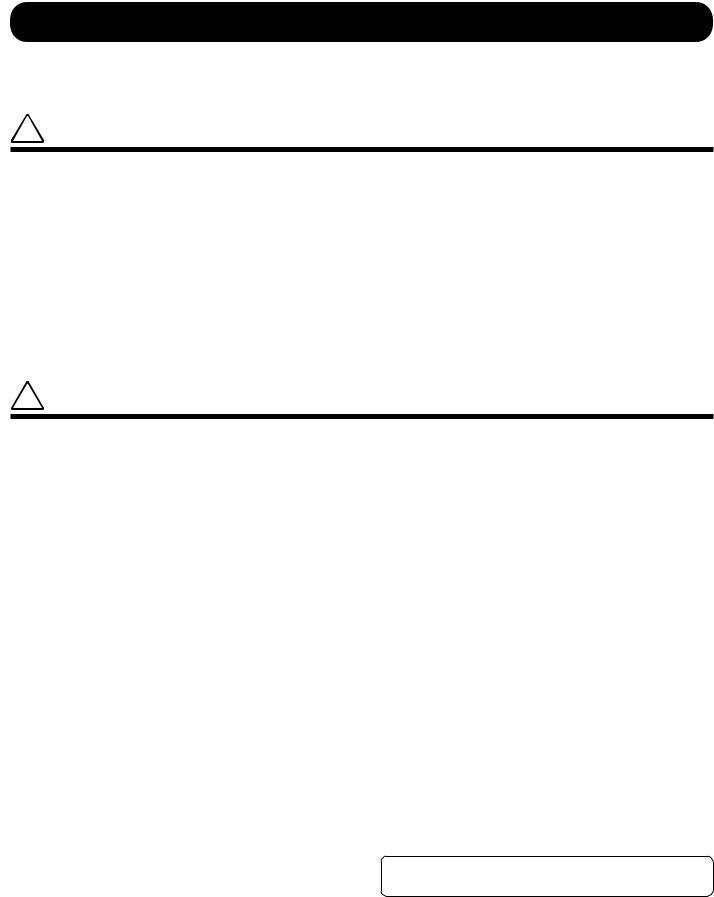
PRECAUTIONS
PLEASE READ CAREFULLY BEFORE PROCEEDING
* Please keep these precautions in a safe place for future reference.
 WARNING
WARNING
Always follow the basic precautions listed below to avoid the possibility of serious injury or even death from electrical shock, shortcircuiting, damages, fire or other hazards. These precautions include, but are not limited to, the following:
•Do not open the instrument or attempt to disassemble the internal parts or modify them in any way. The instrument contains no user-serviceable parts. If it should appear to be malfunctioning, discontinue use immediately and have it inspected by qualified Yamaha service personnel.
•Do not expose the instrument to rain, use it near water or in damp or wet conditions, or place containers on it containing liquids which might spill into any openings.
•If the power cord or plug becomes frayed or damaged, or if there is a sudden loss of sound during use of the instrument, or if any unusual smells or smoke should appear to be caused by it, immediately turn off the power switch, disconnect the electric plug from the outlet, and have the instrument inspected by qualified Yamaha service personnel.
 CAUTION
CAUTION
•Only use the voltage specified as correct for the instrument. The required voltage is printed on the name plate of the instrument.
•Before cleaning the instrument, always remove the electric plug from the outlet. Never insert or remove an electric plug with wet hands.
•Check the electric plug periodically and remove any dirt or dust which may have accumulated on it.
Always follow the basic precautions listed below to avoid the possibility of physical injury to you or others, or damage to the instrument or other property. These precautions include, but are not limited to, the following:
•Do not place the power cord near heat sources such as heaters or radiators, and do not excessively bend or otherwise damage the cord, place heavy objects on it, or place it in a position where anyone could walk on, trip over, or roll anything over it.
•When removing the electric plug from the instrument or an outlet, always hold the plug itself and not the cord. Pulling by the cord can damage it.
•Do not connect the instrument to an electrical outlet using a multiple-connector. Doing so can result in lower sound quality, or possibly cause overheating in the outlet.
•Remove the electric plug from the outlet when the instrument is not to be used for extended periods of time, or during electrical storms.
•Before connecting the instrument to other electronic components, turn off the power for all components. Before turning the power on or off for all components, set all volume levels to minimum.
•Do not expose the instrument to excessive dust or vibrations, or extreme cold or heat (such as in direct sunlight, near a heater, or in a car during the day) to prevent the possibility of panel disfiguration or damage to the internal components.
•Do not use the instrument near other electrical products such as televisions, radios, or speakers, since this might cause interference which can affect proper operation of the other products.
•Do not place the instrument in an unstable position where it might accidentally fall over.
•Before moving the instrument, remove all connected cables.
•When cleaning the instrument, use a soft, dry cloth. Do not use paint thinners, solvents, cleaning fluids, or chemical-impregnated wiping cloths. Also, do not place vinyl, plastic or rubber objects on the instrument, since this might discolor the panel or keyboard.
•Do not rest your weight on, or place heavy objects on the instrument, and do not use excessive force on the buttons, switches or connectors.
•Use only the stand/rack specified for the instrument. When attaching the stand or rack, use the provided screws only. Failure to do so could cause damage to the internal components or result in the instrument falling over.
•Do not place the instrument against a wall (allow at least 3 cm/one-inch from the wall), since this can cause inadequate air circulation, and possibly result in the instrument overheating.
•Do not operate the instrument for a long period of time at a high or uncomfortable volume level, since this can cause permanent hearing loss. If you experience any hearing loss or ringing in the ears, consult a physician.
■REPLACING THE BACKUP BATTERY
•This instrument contains a non rechargeable internal backup battery which permits internal data to remain stored even when the power is off. When the backup battery needs replacing, the message "ERROR1 REPLACE BATTERY" will display in the LCD screen. When this happens, immediately back up your data (using an external device such as the floppy disk-based Yamaha MIDI Data Filer MDF3), then have qualified Yamaha service personnel replace the backup battery.
•Do not attempt to replace the backup battery yourself, in order to prevent the possible serious hazards. Always have qualified Yamaha service personnel replace the backup battery.
•Never place the backup battery in a location that a child can reach, since a child might accidentally swallow the battery. If this should happen, consult a physician immediately.
■SAVING USER DATA
•Save all data to an external device such as the Yamaha MIDI Data Filer MDF3, in order to help prevent the loss of important data due to a malfunction or user operating error.
Yamaha cannot be held responsible for damage caused by improper use or modifications to the instrument, or data that is lost or destroyed.
Always turn the power off when the instrument is not in use.
(1)-2

CONTENTS
INTRODUCTION............................................................................................................ |
5 |
PRECAUTIONS.............................................................................................................. |
6 |
UPPER PANEL .............................................................................................................. |
8 |
REAR PANEL............................................................................................................... |
13 |
P-200 OVERVIEW........................................................................................................ |
14 |
GETTING STARTED .................................................................................................... |
18 |
Setting up the P-200....................................................................................................................... |
18 |
Turning on the Power...................................................................................................................... |
20 |
Playing the Demo Songs................................................................................................................. |
21 |
Playing the Voices........................................................................................................................... |
22 |
VOICE PLAY MODE ............................................................................................................ |
23 |
Single Mode.................................................................................................................................... |
24 |
Stereo/Mono Piano ......................................................................................................................... |
25 |
Upright/Electric Bass....................................................................................................................... |
25 |
Reverb Effects................................................................................................................................. |
26 |
Modulation Effects .......................................................................................................................... |
27 |
Panel Equalizer ............................................................................................................................... |
29 |
Main and Sub Voices ...................................................................................................................... |
29 |
Dual Mode ...................................................................................................................................... |
30 |
Split Mode ...................................................................................................................................... |
32 |
Transpose....................................................................................................................................... |
37 |
MIDI Transmit Enable ...................................................................................................................... |
40 |
MIDI Panic ...................................................................................................................................... |
41 |
Panel Switch Lock .......................................................................................................................... |
41 |
PERFORMANCE PLAY MODE ........................................................................................... |
45 |
Selecting Single Voices ................................................................................................................... |
46 |
Selecting Dual Voices...................................................................................................................... |
47 |
Selecting Split Voices...................................................................................................................... |
47 |
EDIT MODE ......................................................................................................................... |
49 |
System ........................................................................................................................................... |
51 |
MIDI Filter........................................................................................................................................ |
53 |
Program Change (PC) Table............................................................................................................ |
53 |
Channel .......................................................................................................................................... |
54 |
Local............................................................................................................................................... |
55 |
Continuous Slider (CS) / Foot Controller (FC)................................................................................... |
55 |
Panel Switch (PS)............................................................................................................................ |
57 |
Name.............................................................................................................................................. |
57 |
Organ Combination......................................................................................................................... |
57 |
Pitch Bend Wheel (PB) / Modulation Wheel (MW) ............................................................................ |
58 |
Keyboard Sensitivity........................................................................................................................ |
58 |
Internal Equalizer............................................................................................................................. |
59 |
Reverb ............................................................................................................................................ |
59 |
Modulation...................................................................................................................................... |
59 |
STORE................................................................................................................................. |
60 |
APPENDIX........................................................................................................................... |
62 |
Bulk Dump....................................................................................................................................... |
62 |
Initialize ........................................................................................................................................... |
63 |
Using MIDI ...................................................................................................................................... |
64 |
Error Messages............................................................................................................................... |
67 |
Troubleshooting .............................................................................................................................. |
68 |
Specifications................................................................................................................................... |
70 |
Index................................................................................................................................................ |
71 |
Factory Default Settings ................................................................................................................... |
72 |
Blank Chart...................................................................................................................................... |
78 |
MIDI Data Format............................................................................................................................. |
80 |
MIDI Implementation Chart............................................................................................................... |
89 |
The LCD screen displays as illustrated in this manual are for instructional purposes only, and may appear somewhat different from your P-200’s.
7
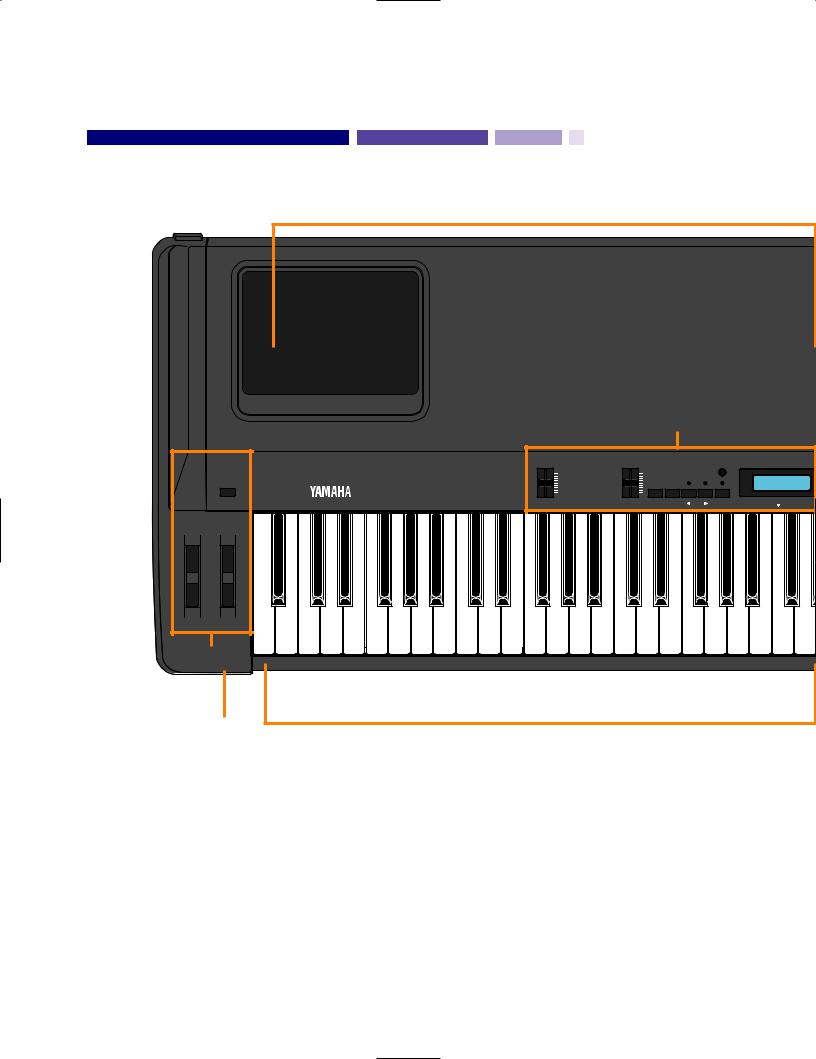
UPPER PANEL
|
|
|
|
|
B |
|
|
|
|
|
|
VOLUME |
CS |
|
|
|
|
CONTRAST |
|
|
|
|
MAX |
|
|
|
|
|
|
|
POWER |
|
PS1 |
PS2 |
SPLIT |
TRANSPOSE |
MIDI |
|
|
|
|
|
|
|
|||||
|
|
|
MIN |
|
|
|
|
|
|
|
ON/ |
OFF |
|
|
|
BALANCE |
DETUNE |
|
C3 |
|
|
|
DATA ENTRY |
-1/NO |
+1/YES |
|
|
PAGE |
|
PITCH |
MODULATION |
|
|
|
|
|
|
|
|
|
A |
|
|
|
|
|
|
|
|
|
! |
|
|
|
|
|
|
|
|
! [PHONES] jack |
|
# Speakers |
|
|
|
|
|
|
|
This jack on the front panel lets you connect a pair of stereo headphones to the P-200 for private listening. The internal speakers will automatically be disconnected when you plug in the headphones. The sound of the internal voices output from the [OUTPUT] jacks is not affected.
These two built-in 13 cm speakers each provide an output of 30 watts. If you connect the P-200 to an external monitor system, you may choose to turn the speakers off using the [SPEAKER] switch located on the rear panel.
" Keyboard
This 88-key weighted action, touch-sensitive keyboard incorporates Yamaha’s unique Graded Hammer Effect keyboard technology, which gives it the genuine feel and response of a real piano keyboard.
8

#
IN |
OUT |
THRU |
FOOT CONTROLLER |
SOFT |
SOSTENUTO SUSTAIN |
L/MONO |
R |
L/MONO |
R |
OFF ON |
|
MIDI |
|
|
|
|
OUTPUT |
|
INPUT |
|
SPEAKER |
C
|
|
|
|
|
|
|
|
|
|
|
|
|
|
|
EFFECT |
|
STORE |
PERF. A |
|
|
|
|
|
|
|
|
|
|
|
|
|
|
EQUALIZER |
|
|
|
|
|
|
|
|
|
|
|
|
|
|
|
REVERB |
MODULATION |
|
|
|
1 |
2 |
3 |
4 |
5 |
6 |
7 |
8 |
9 |
10 |
11 |
12 |
ROOM |
CHORUS |
|
|
|
|
|
|
|
|
|
|
|
|
|
|
|
STAGE |
SYMPHONIC |
EDIT |
PERF. B |
VOICE |
PIANO 1 |
PIANO 2 |
PIANO 3 |
PIANO 4 |
E.PIANO 1 |
E.PIANO 2 |
E.PIANO 3 |
VIBES |
ORGAN 1 |
ORGAN 2 |
STRINGS |
BASS |
HALL |
TREMOLO |
SYSTEM MIDI FILTER PC TABLE CHANNEL LOCAL CS FC |
PS |
NAME ORGAN |
PB MW KBD SENS. INT.EQ |
|
|
ELECTRONIC PIANO P-200 |
|
|
|
COMBINATION |
LOW |
MIDDLE |
HIGH |
||
|
|
|
|
|
|
|
|
|
|
|
|
|
|
|
|
|
|
|
|
|
|
|
|
|
|
|
|
|
|
|
|
|
|
|
|
|
|
|
|
"
9
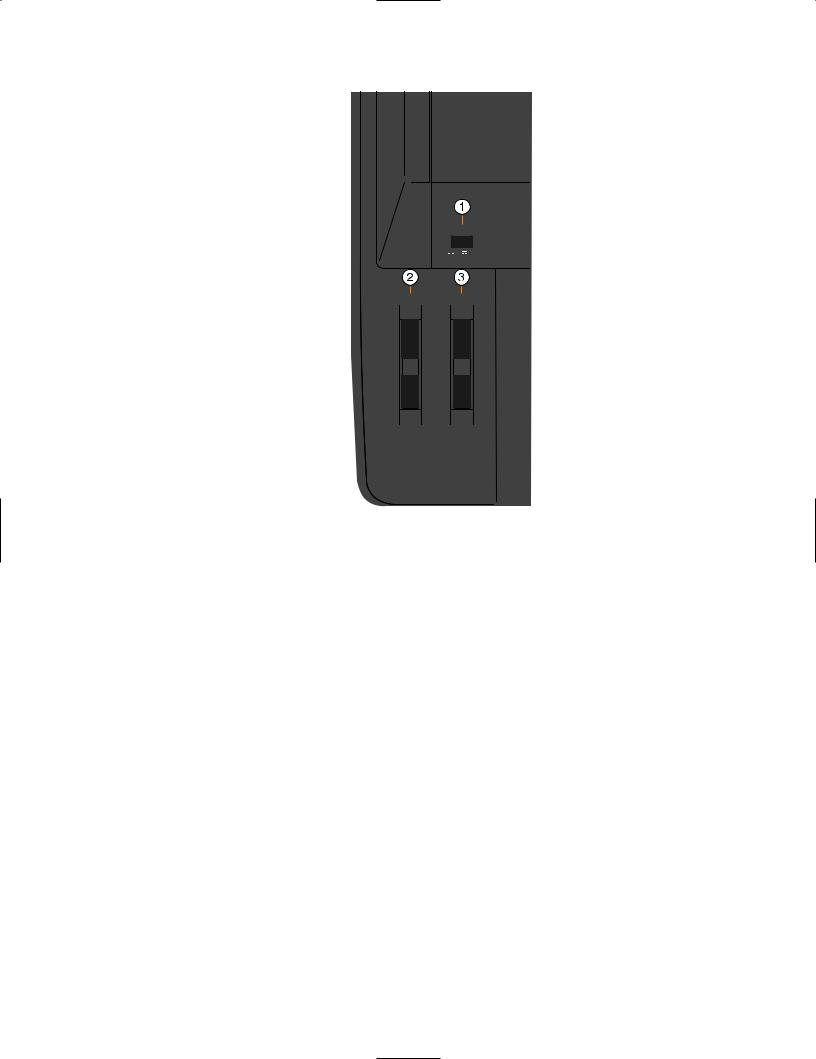
■ UPPER PANEL—A
POWER
 ON/
ON/  OFF
OFF
PITCH |
MODULATION |
! [POWER] switch
This switch turns the power on and off. When the power is turned on, the mode and status designated when the power was previously turned off will still be active (with the exception of Panel Swicth Lock; page 41).
" [PITCH] wheel
This wheel can be used to bend the pitch of the notes that you play, up or down; the wheel automatically returns to the center position when you release it. (In Dual mode, both voices are affected; in Split mode, only the main voice is affected.) When the MIDI Transmit Switch is enabled, you can use it to transmit pitch bend messages to other instruments. You can assign the pitch bend range to any value within a one-octave range.
# [MODULATION] wheel
This wheel can be used in various ways. Normally you will use it to apply a vibrato effect to the notes that you play, with increasing intensity as you roll it upwards; the wheel remains at the specific position that you set it when you let go of it. (In Dual mode, both voices are modulated; in Split mode, only the main voice is modulated. The vibrato effect cannot be applied to Piano voices 1 ~ 4.) You can also assign it to control reverb depth or modulation speed. When MIDI transmission is enabled, you can use it to transmit modulation messages to other instruments.
10
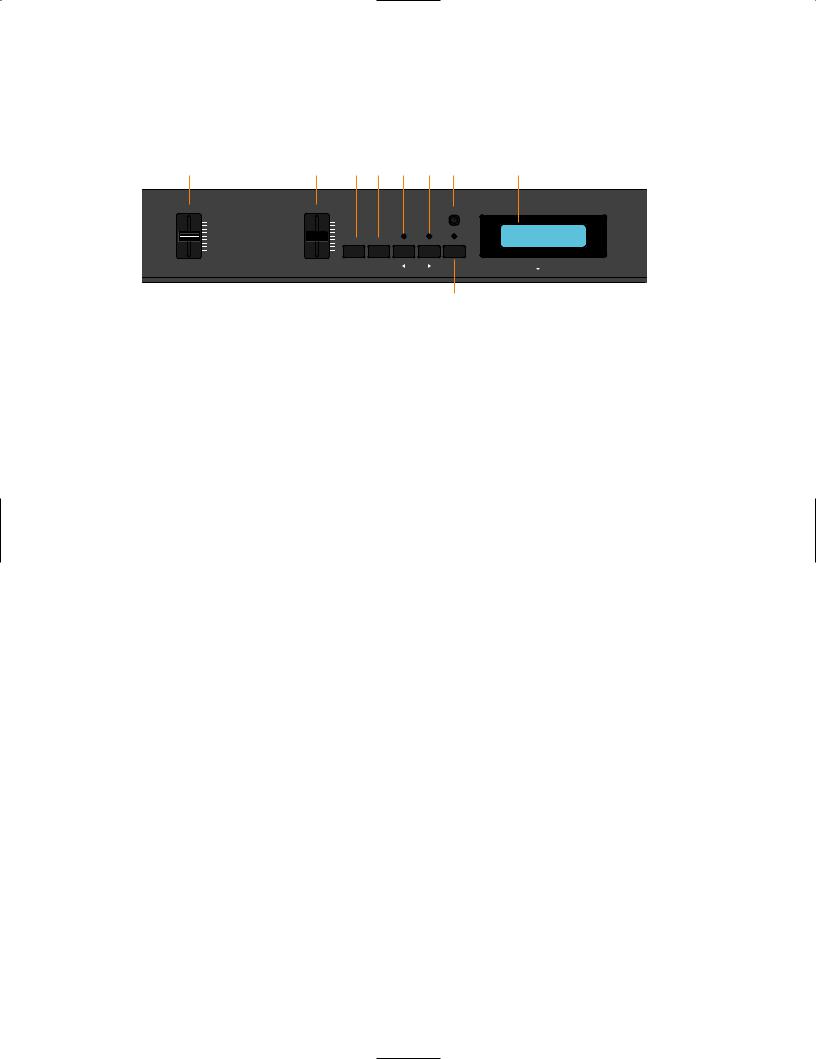
■ UPPER PANEL— B
! |
" |
# $ % & ( |
) |
|||
VOLUME |
CS |
|
|
|
CONTRAST |
|
|
|
|
|
|
|
|
|
MAX |
|
|
|
|
|
|
|
PS1 |
PS2 |
SPLIT |
TRANSPOSE MIDI |
|
|
MIN |
|
|
|
|
|
|
|
|
|
BALANCE |
DETUNE |
C3 |
|
DATA ENTRY |
-1/NO |
+1/YES |
|
PAGE |
|
|
|
|
||||
'
! [VOLUME] slider
This slider adjusts the overall volume of sound output from the internal speakers (or headphones, if connected) as well as the sound output from the [OUTPUT] jacks on the rear panel. Moving the slider upward increases volume level, while moving the slider downward decreases volume level.
" [CS, DATA ENTRY] slider
This is a multiple function slider. As a [CS] (continuous slider), you can assign it to control a variety of functions. As a [DATA ENTRY] slider, you can use it to change specific settings and parameters, depending on the current mode and status. Moving the slider upward increases the specified value, while moving the slider downward decreases the specified value.
# [PS1, –1/NO] button
This is a dual function button. As a [PS1] (Panel Switch 1) button, you can assign it to control various functions of the internal voices as well as connected MIDI devices, as set by the PS Edit function. As a [–1/NO] button, you can use it to change parameter settings in decrements.
& [TRANSPOSE, DETUNE, q] button
This is a multiple function button. As a [TRANSPOSE] button, you can use it to set the keyboard transpose value for single as well as both Dual voices or Split voices. As a [DETUNE] button, you can use it to set the detune value for the two Dual voices, by holding it and moving the [DATA ENTRY] slider ". As a [q] (cursor right) button in Edit mode, you can use it to move the cursor to the right in the LCD screen in order to position it over a desired parameter.
' [MIDI, PAGE] button
This is a dual function button. As a [MIDI] transmit button, you can use it to quickly enable or disable the P-200’s transmission of MIDI messages. You can also hold the [MIDI] button while pressing other buttons to access certain features. As a [PAGE] button, you can use it to step through the various pages of Edit functions when the P-200 is in Edit mode.
( [CONTRAST] dial
This dial lets you adjust the contrast of the LCD screen for optimum visibility. Rotating it to the left will decrease screen contrast, while rotating it to the right will increase screen contrast.
$ [PS2, +1/YES] button
This is a dual function button. As a [PS2] (Panel Switch 2) button, you can assign it to control various functions of the internal voices as well as connected MIDI devices, as set by the PS Edit function. As a [+1/YES] button, you can use it to change parameter settings in increments.
) LCD screen
This backlit 32-character Liquid Crystal Display screen provides various information about the modes and operating status of the P-200. Certain messages are displayed only temporarily, but you can designate the “Popup Time” according to your preference.
% [SPLIT, BALANCE, 1] button
This is a multiple function button. As a [SPLIT] button, you can use it to enter Split mode, whether in Voice Play or Performance Play mode, determine the split point and assign the keyboard area for the main and sub voices. As a [BALANCE] button, you can use it to set the relative volume levels of each Split and Dual voice, by holding the [BALANCE] button and moving the [DATA ENTRY] slider ". As a [1] (cursor left) button in Edit mode, you can use it to move the cursor to the left in the LCD screen in order to position it over a desired parameter.
11
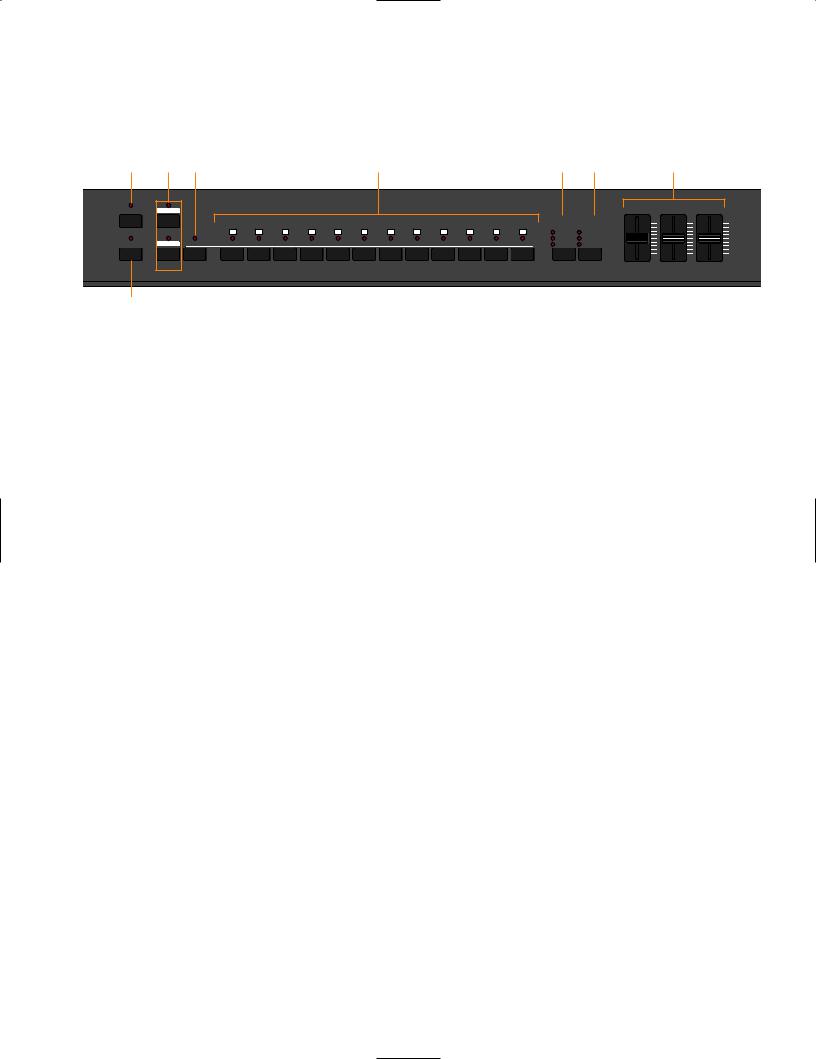
■ UPPER PANEL—C
! |
# $ |
|
|
|
|
|
% |
|
|
|
|
|
& |
' |
( |
|
|
|
|
|
|
|
|
|
|
|
|
|
|
|
|
EFFECT |
EQUALIZER |
|
|
STORE |
PERF. A |
|
|
|
|
|
|
|
|
|
|
|
|
|
|
|
|
|
|
|
|
|
|
|
|
|
|
|
|
|
|
|
|
||
|
|
|
|
|
|
|
|
|
|
|
|
|
|
REVERB |
MODULATION |
|
|
|
|
1 |
2 |
3 |
4 |
5 |
6 |
7 |
8 |
9 |
10 |
11 |
12 |
ROOM |
CHORUS |
|
|
|
|
|
|
|
|
|
|
|
|
|
|
|
|
STAGE |
SYMPHONIC |
|
|
EDIT |
PERF. B VOICE |
PIANO 1 |
PIANO 2 |
PIANO 3 |
PIANO 4 |
E.PIANO 1 |
E.PIANO 2 |
E.PIANO 3 |
VIBES |
ORGAN 1 |
ORGAN 2 |
STRINGS |
BASS |
HALL |
TREMOLO |
|
|
|
|
|
|
|
|
|
|
|
|
|
|
|
|
|
|
|
|
|
|
SYSTEM |
MIDI FILTER |
PC TABLE |
CHANNEL |
LOCAL |
CS FC |
PS |
NAME |
ORGAN |
PB MW |
KBD SENS. |
INT.EQ |
|
|
|
|
|
|
|
|
|
|
|
|
|
|
COMBINATION |
|
|
|
|
LOW |
MIDDLE |
HIGH |
|
|
|
|
|
|
|
|
|
|
|
|
|
|
|
|||
"
! [STORE] button
This button lets you store changes that you make to a Performance, as well as copy the current Performance into any Performance memory. The P-200 can store 24 Performances.
" [EDIT] button
This button lets you enter Edit mode and access the various Edit functions. After pressing it once, the LED above the [EDIT] button will begin blinking, as will the light above the currently selected [EDIT SELECT] button %. Pressing it again will return you to the previous Play mode.
% [VOICE, PERFORMANCE, EDIT SELECT] buttons
These 12 buttons each have multiple functions, depending on the current mode. In Voice Play mode you can use them to select any of the 12 preset AWM instrument voices you want to play; the voice names are printed in above the buttons. In Performance Play mode you can use them to select any of the 24 Performances (12 Performances per bank); the Performance numbers are printed above the buttons. In Edit mode, you can use them to select the Edit functions; the Edit function names are printed in green below the buttons.
# [PERF. A, B] buttons
These buttons let you enter Performance Play mode and select any of the 24 Performances. The P-200 is set at the factory with 24 Preset Performances, but you can overwrite them and store User Performances which you create yourself. The [PERF. A] and [PERF. B] banks hold 12 Performances each, and a lit LED above one of the buttons indicates the currently active bank.
$ [VOICE] button
This button lets you enter Voice Play mode by pressing [VOICE] and then pressing a [VOICE SELECT] button %. A lit LED above the [VOICE] button indicates you’re in Voice Play mode.
& [REVERB] button
This button lets you select either a Room, Stage or Hall reverb effect, or no reverb effect, to apply to the currently selected voice. Each voice has a default reverb setting preprogrammed at the factory which you can change.
' [MODULATION] button
This button lets you select either a Chorus, Symphonic or Tremolo modulation effect, or no modulation effect, to apply to the currently selected voice. Each voice has a default modulation setting preprogrammed at the factory which you can change.
( [EQUALIZER] sliders
These sliders let you graphically adjust the level of the sound output of the P-200 in three bands: High, Middle and Low. In Dual and Split modes, the changes you make will affect both voices.
12
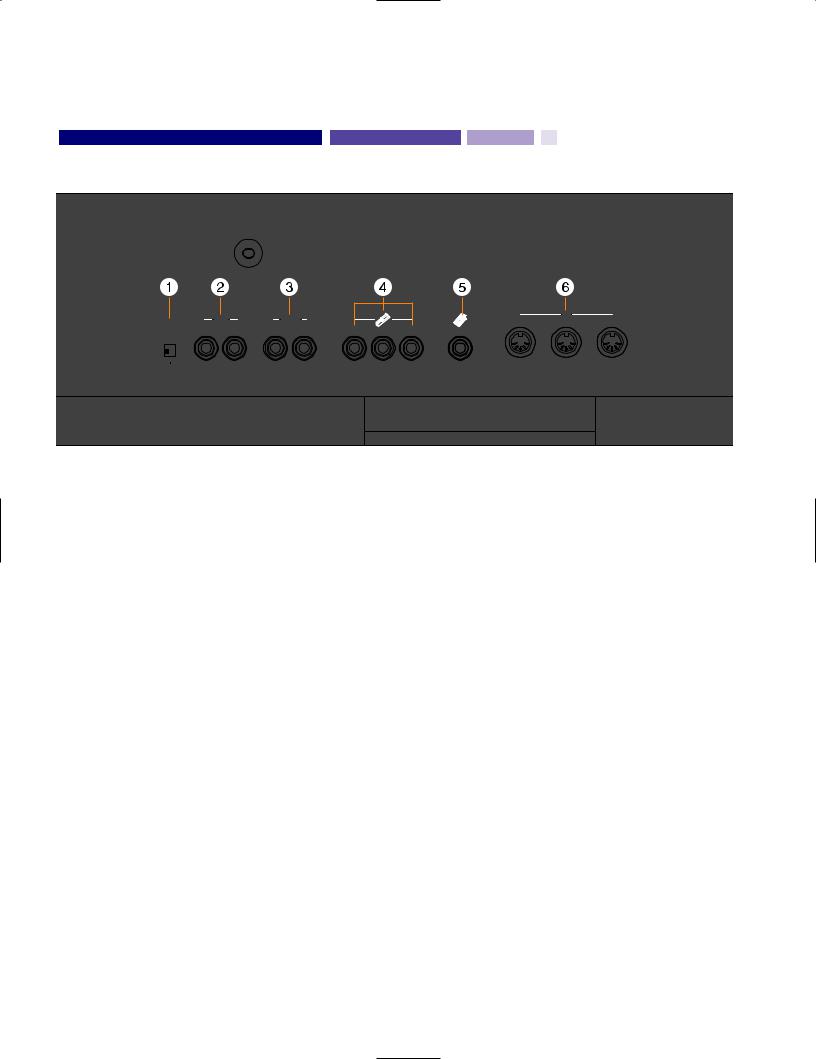
REAR PANEL
|
|
|
|
|
|
|
|
|
|
MIDI |
|
|
|
|
INPUT |
|
OUTPUT |
|
|
|
THRU |
OUT |
IN |
SPEAKER |
|
|
|
|
|
|
|
|
|
|
|
ON |
OFF |
R |
L/MONO |
R |
L/MONO |
SUSTAIN |
SOSTENUTO |
SOFT |
FOOT CONTROLLER |
|
|
! [SPEAKER] switch
This switch lets you turn off the P-200’s internal speakers. It does not affect the output from the [OUTPUT] jacks or the [PHONES] jack.
" [INPUT] jacks
These jacks let you input line-level signals from another electronic instrument, such as a rhythm programmer, external tone generator, or synthesizer, and monitor it through the P-200’s internal speakers. Use the [L/MONO] jack when connecting only a single line.
# [OUTPUT] jacks
These jacks output line-level signals which can be input directly to an external amplifier, mixer or other audio device. Use the [L/MONO] jack if your audio equipment has only one input.
$ Pedal jacks
These jacks let you connect up to three foot pedals and use them as sustain, sostenuto and soft pedals. A single FC4 footswitch is included with your P-200. If you wish to attach additional foot pedals, be sure to use only Yamaha models FC4 or FC5.
% [FOOT CONTROLLER] jack
This jack lets you connect a foot controller (Yamaha FC7, available separately) for use as an auxiliary controller. The [FC] foot controller can be assigned to control a variety of functions, including reverb depth or modulation speed, which lets you change these parameters by foot as you play.
& [MIDI] terminals
These terminals allow the P-200 to communicate with other MIDI devices, using standard MIDI cables. To control the P-200 using a sequencer or another keyboard, connect the MIDI out jack of the external device to the [MIDI IN] jack of the P-200. To control another device (such as a synthesizer or tone generator) using the P-200, connect the [MIDI OUT] jack of the P-200 to the MIDI in jack of the external device. The [MIDI THRU] jack simply passes the data received at the P-200’s [MIDI IN] jack through unaffected, and is used when connecting three or more MIDI devices in a series.
13
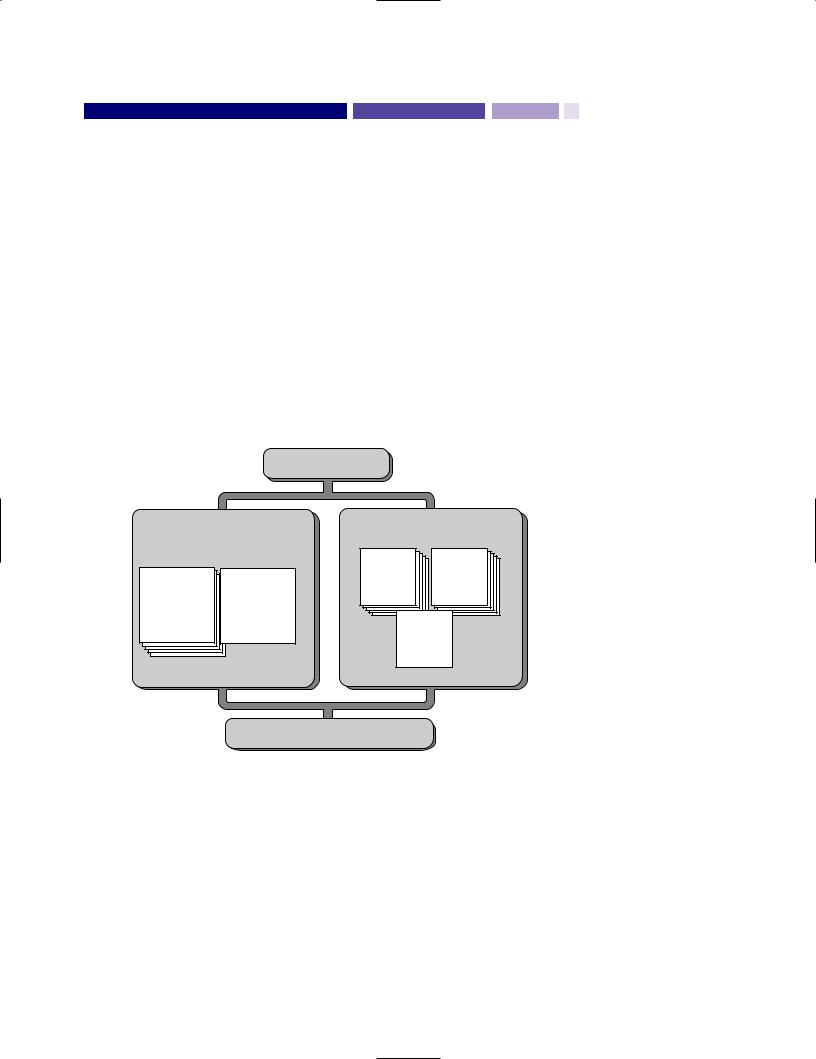
P-200 OVERVIEW
The Yamaha P-200 is a versatile electronic piano with very high fidelity piano and other sounds and the genuine touch and response of a real piano.
In its simplest form of use, all you really need to do is switch it on and start playing! However, this is just barely scratching the surface, since the P-200 has powerful performance and MIDI master keyboard capabilities.
Below is an overview of the basic operating modes and the system structure of the P-200, with explanations of how the various features relate to each other during practical use of the instrument.
■Voice Play and Performance Play Modes
The P-200 has two basic Play modes, Voice Play mode and Performance Play mode. Within each mode are various Voice and Performance parameters, or settings that you can change, which make up the sound of the selected voice and the specific operating status of the P-200.
A group of overall System settings apply to both Voice Play and Performance Play modes, and Edit mode lets you access and edit a wide variety of System and other functions, as shown in the following illustration.
As the above illustration shows, the primary difference between Voice Play mode and
SYSTEM
VOICE PLAY MODE |
PERFORMANCE PLAY MODE |
||
|
|
PERF. A |
PERF. B |
|
|
01~12 |
01~12 |
VOICE 01~12 |
PERFORMANCE |
|
|
PARAMETERS |
|
|
|
|
|
|
|
|
|
|
VOICE |
|
|
PARAMETERS |
|
EDIT MODE / STORE FUNCTIONS
Performance Play mode is:
■In Voice Play mode, a single set of Performance parameter settings apply to any voice (and its specified Voice parameter settings) which you select.
■In Performance Play mode, a complete set of Performance parameters can be configured specifically for any particular voice (and its specified Voice parameter settings). The P-200 can store up to 24 Performances for instant recall.
Normally you will operate in Voice Play mode, Auto Store status (See “About Store Type”, next page)—as you select sounds and make parameter assignments as dictated by your current music session. Then you can store those settings to any of the 24 Performances, which you can then access at any time by the press of a [PERFORMANCE SELECT] button in Performance Play mode. (You can also perform bulk dump operations of Performance data to and from an external MIDI device such as the Yamaha MDF3 MIDI Data Filer.)
14

ABOUT STORE TYPE
You can choose the Store Type—Non Auto Store and Auto Store.
When Non Auto Store is selected, the store operation is always required (except when modifying System related parameters; see page 17) if you want to save the current settings.
When Auto Store is selected, all changes you make will automatically be stored without the need to perform a specific storing procedure.
The default setting for a new (or initialized) P-200 is Non Auto Store. (For information about changing the Store Type, see page 52.)
Explanations in this Owner’s Manual assume that Auto Store is selected. Therefore, the LCD illustrations herein may be slightly different than the screens on your P-200.
■ Voice Parameters
In Voice Play mode, each of the P-200’s AWM instrument voices have a set of Voice parameters that are initially set at the factory, but which you can change to suit your needs.
These include controller parameters such as pitch bend range and modulation wheel assignment, keyboard sensitivity parameters for internal or MIDI applications, and effect parameters such as reverb type and depth, modulation type and speed, and internal equalizer settings.
In Voice Play mode you can access a single set of Performance parameters and in Performance Play mode you can access 24 sets of Performance parameters. Although you can freely change the voices in Performance Play mode, only a single set of Voice parameters is available for each Performance.
VOICE PARAMETERS
CONTROLLERS |
• Pitch Bend Range |
|
• Modulation Wheel Assign |
||
|
||
|
|
|
KEYBOARD SENSITIVITY |
• Internal |
|
• MIDI |
||
|
||
|
|
|
|
• Reverb Type, Speed |
|
EFFECT |
• Modulation Type, Speed |
|
|
• Equalizer (Internal) Low, Mid, High |
|
|
|
15
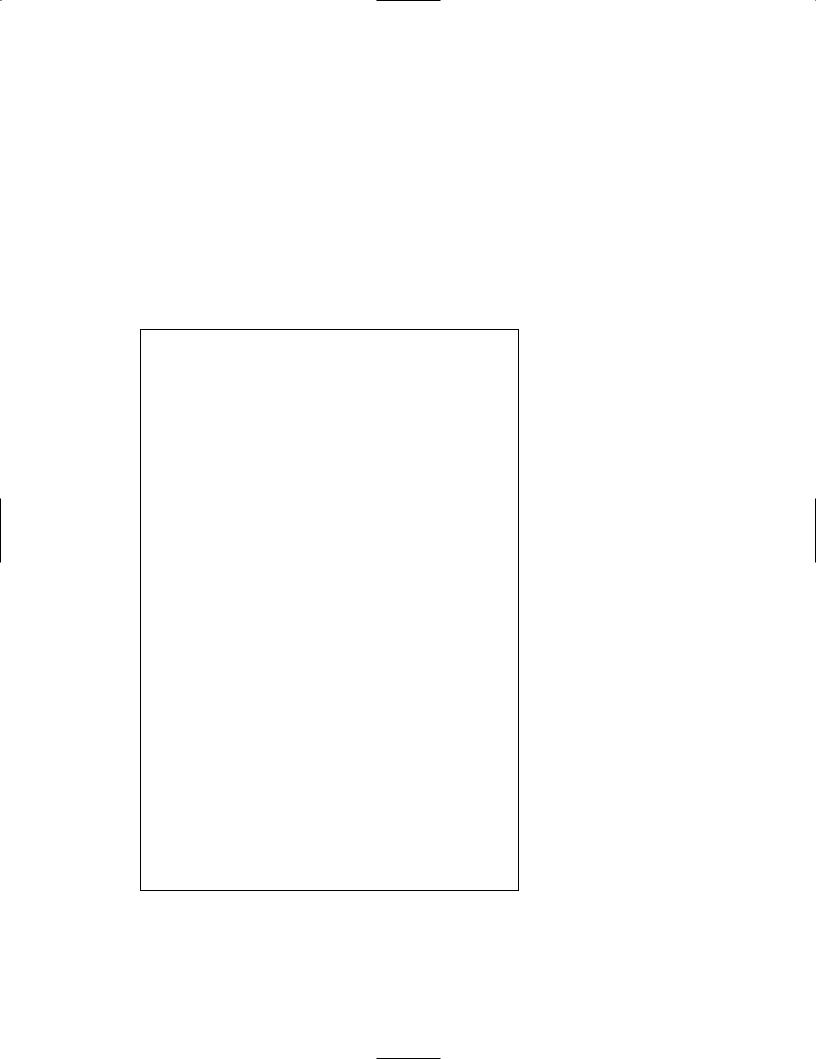
■ Performance Parameters
In Performance Play mode, the P-200 has 24 sets of Performance parameters which let you configure settings for specific music situations (i.e., for a certain style of music, or a particular song, or for a practice session, or a live set, etc.). This affords you the convenience of being able to recall those settings instantly at the press of a button when in Performance Play mode.
Performance parameters include the voice selection (a set of voice parameters), keyboard Single, Dual or Split mode and settings, main and sub voice assignments, User organ combination values, transposition values, keyboard local on or off setting, MIDI transmit and receive channel numbers, plus function assignments for [PS1], [PS2], [CS] and [FC] (foot controller), the Performance name and others.
In Voice Play mode you can specify settings for a single set of Performance parameters.
Performance Parameters
VOICE SELECT |
12 voices |
|
(A set of voice parameters) |
||
|
||
|
|
|
KEYBOARD MODE |
Single, Dual, Split |
|
|
|
|
VOICE |
Main, Sub |
|
|
|
|
PIANO 1/2 |
Stereo, Mono |
|
|
|
|
BASS |
Upright, Electric |
|
|
|
|
|
• Footage |
|
ORGAN COMBINATION |
• Response, |
|
|
Attack (Length and Mode) |
|
|
|
|
BALANCE |
–16 ~ 15 |
|
|
|
|
DETUNE |
0 ~ 7 |
|
|
|
|
SPLIT POINT |
• A-1 ~ C7 |
|
• MAIN VOICE (Upper, Lower) |
||
|
||
|
|
|
|
• Enable Switch |
|
TRANSPOSE |
• Internal Main, Sub |
|
|
• MIDI Main, Sub |
|
|
|
|
MIDI CHANNEL |
• Transmit |
|
• Receive |
||
|
||
|
|
|
LOCAL |
On, Off |
|
|
|
|
|
• PS 1/2 Assign |
|
CONTROLLERS |
• CS Assign, Range |
|
|
• FC Assign, Range |
|
|
|
|
NAME |
Character select |
|
|
|
16

■ System Settings
The P-200’s overall System settings encompass those “global” parameters which are related to the instrument as a whole, and which therefore affect both Voice Play and Performance Play modes.
These include master tuning, MIDI transmit enable, MIDI filter transmit and receive parameter settings, MIDI program change table settings, and others.
SYSTEM
MIDI TRANSMIT ENABLE |
On, Off |
|
|
|
|
|
• Master Tune |
|
|
• Reverb Bypass |
|
|
• Device Number |
|
SYSTEM |
• MIDI Merge |
|
|
• Performance Enable |
|
|
• Popup Time |
|
|
• Store Type |
|
|
• Panel Switch Lock Mode |
|
|
|
|
MIDI FILTER |
• Transmit |
|
• Receive |
|
|
|
|
|
|
|
|
|
• Transmit Number, Bank |
|
PROGRAM CHANGE TABLE |
Select Number |
|
|
• Receive Number |
|
|
|
|
■ Editing and Storing Features
When the P-200 is in Edit mode, you can access and modify the System and other parameters.
A convenient Auto Store feature (which you can disengage) automatically stores the System settings and other parameters as you change them. Within either Voice Play mode or Performance Play mode, you can store the current set of all settings as a User Performance.
There is a fine distinction between Voice Play mode store and Performance Play mode store functions. In Voice Play mode, you can overwrite the current set of Voice and Performance parameter settings. In Performance Play mode, you can select a specific destination Performance in which to store the current Performance parameter settings. Therefore, if you select a destination Performance in which to store the current Voice Play mode Performance parameter settings, you are storing it in the Performance Play mode.
You will find it most convenient to set up your Performances in Voice Play mode, Auto Store status, since voice selection is so simple, then copy it to one of the 24 Performance memories for instant recall when you need it.
By switching into Non Auto Store status, you can be sure that your Performances are protected, and any changes you make in one will not be applied unless you specifically store, or overwrite, it. In Edit mode, the P-200 will prompt you automatically whether or not to overwrite the current changes.
You can also dump Performance data to and from external MIDI devices.
 NOTE
NOTE
Descriptions of all parameters and details about how to access and manipulate them are provided in the appropriate sections herein. Also see the Blank Chart on page 78.
17
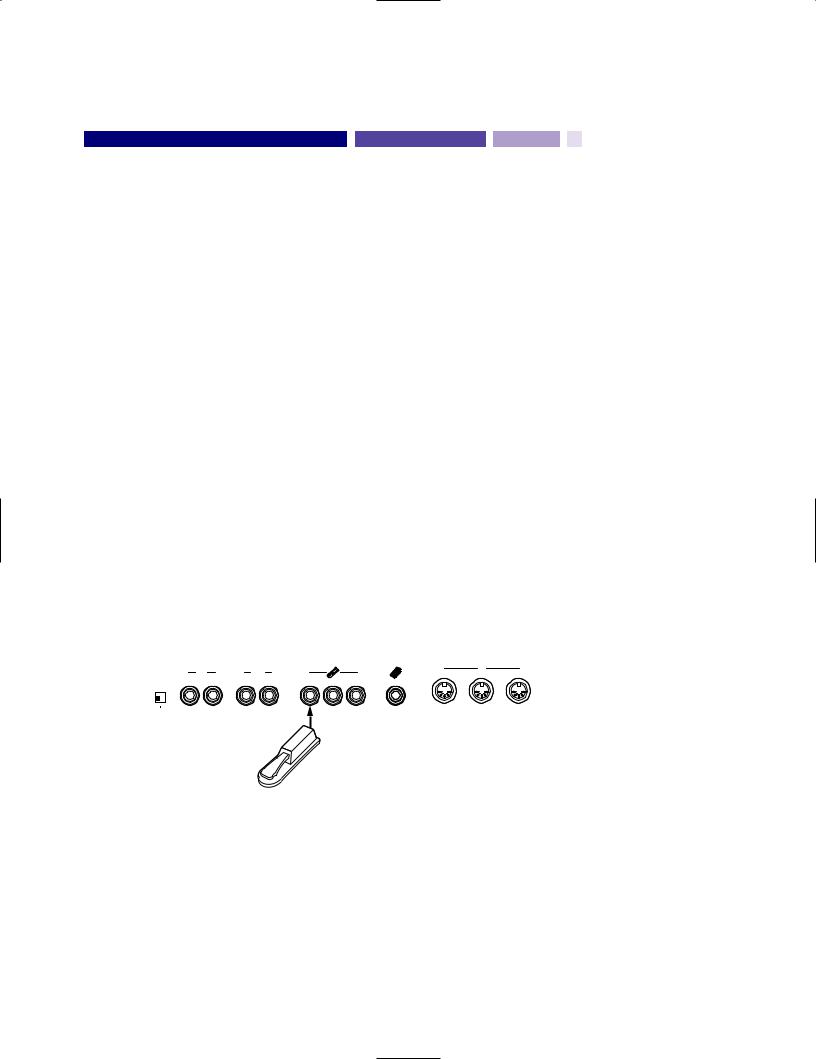
GETTING STARTED
This section explains how to set up the P-200 and the proper procedure for turning it on, playing the preprogrammed Demo songs, and basic voice selection.
■ Setting up the P-200
Although setting up the P-200 for basic play is easy and straightforward, be sure to take heed of the Precautions on page 6 before you begin, then carefully follow the simple steps as outlined below.
P-200 SETUP PROCEDURE
1.
2.
3.
Prepare a suitable location.
The P-200 is relatively small for an 88-key instrument, but it is very solidly built and therefore quite heavy. First you’ll want to prepare a suitable location for your P-200. Please do not hesitate to ask someone to help you take it out of the box and carefully place it on an optionally available Yamaha LP-3 keyboard stand or a sturdy table.
Plug in the power cord.
Next plug the P-200’s power cord into an AC outlet. Do not turn on the [POWER] switch until you have made all connections as described below.
Connect the sustain pedal.
Next plug the supplied FC4 footswitch into the [SUSTAIN] jack on the rear panel, so you can use it as a sustain pedal. If you have purchased additional FC4 or FC5 footswitches, connect them to the [SOSTENUTO] and [SOFT] jacks.
|
|
|
|
|
|
|
MIDI |
|
|
|
INPUT |
|
OUTPUT |
|
THRU |
OUT |
IN |
SPEAKER |
|
|
|
|
|
|
|
|
ON OFF |
R |
L/MONO |
R |
L/MONO |
SUSTAIN SOSTENUTO SOFT |
FOOT CONTROLLER |
|
|
Footswitch FC4
18
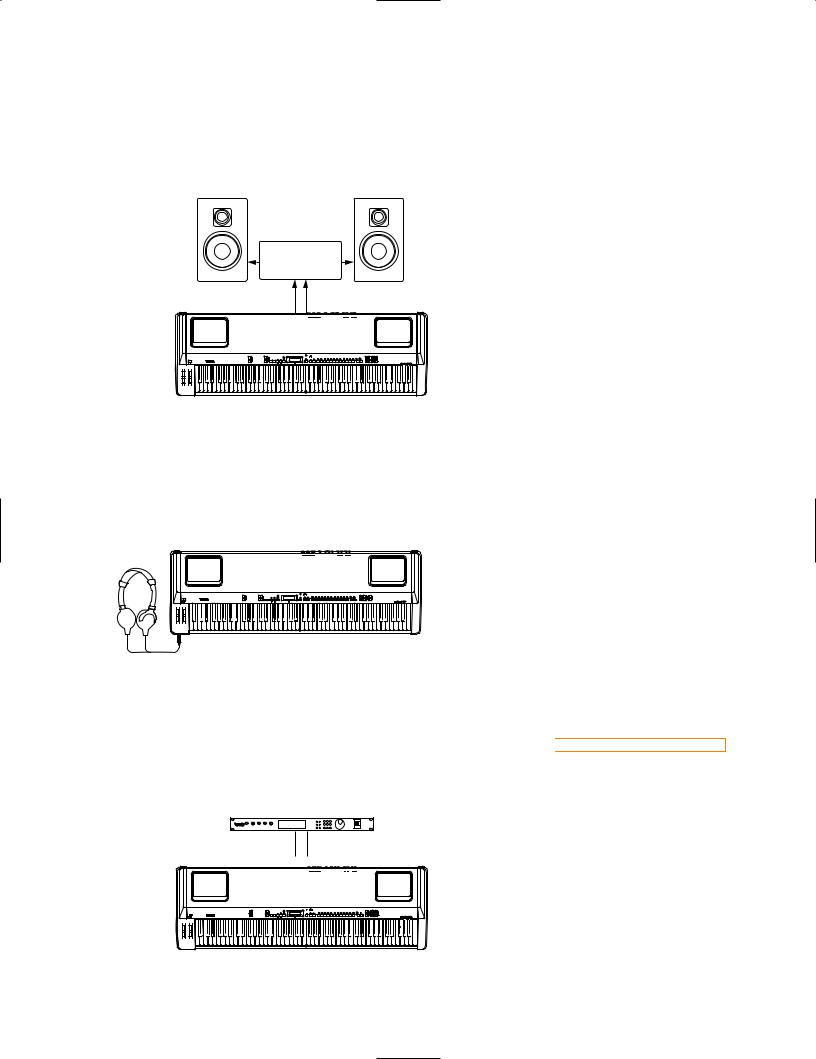
4.Connect external line-level components.
If you wish to monitor the P-200’s output using an external line-level mixer or amplifier, connect the input of the external component to the P-200’s [OUTPUT] jacks on the rear panel. (Use both jacks for stereo output; use the [L/MONO] jack for mono output.)
Speaker (L) |
Speaker (R) |
Amp
OUTPUT L/MONO OUTPUT R
P-200
If you wish to listen to your P-200 using headphones, connect a pair of stereo headphones to the [PHONES] jack located on the left side of the front panel. The P-200’s internal speakers will automatically be disconnected whenever headphones are plugged into the [PHONES] jack.
P-200
If you wish to monitor the output of an external line-level device (such as a rhythm programmer, tone generator or synthesizer) via the P-200’s internal speakers, connect the output of the external device to the P-200’s [INPUT] jacks on the rear panel. (Use both jacks for stereo input; use the [L/MONO] jack for mono input.)
Tone Generator
INPUT L/MONO
 INPUT R
INPUT R
P-200
 CAUTION
CAUTION
Before connecting the P-200 to any external device, be sure that the power switches of all devices are turned off.
19
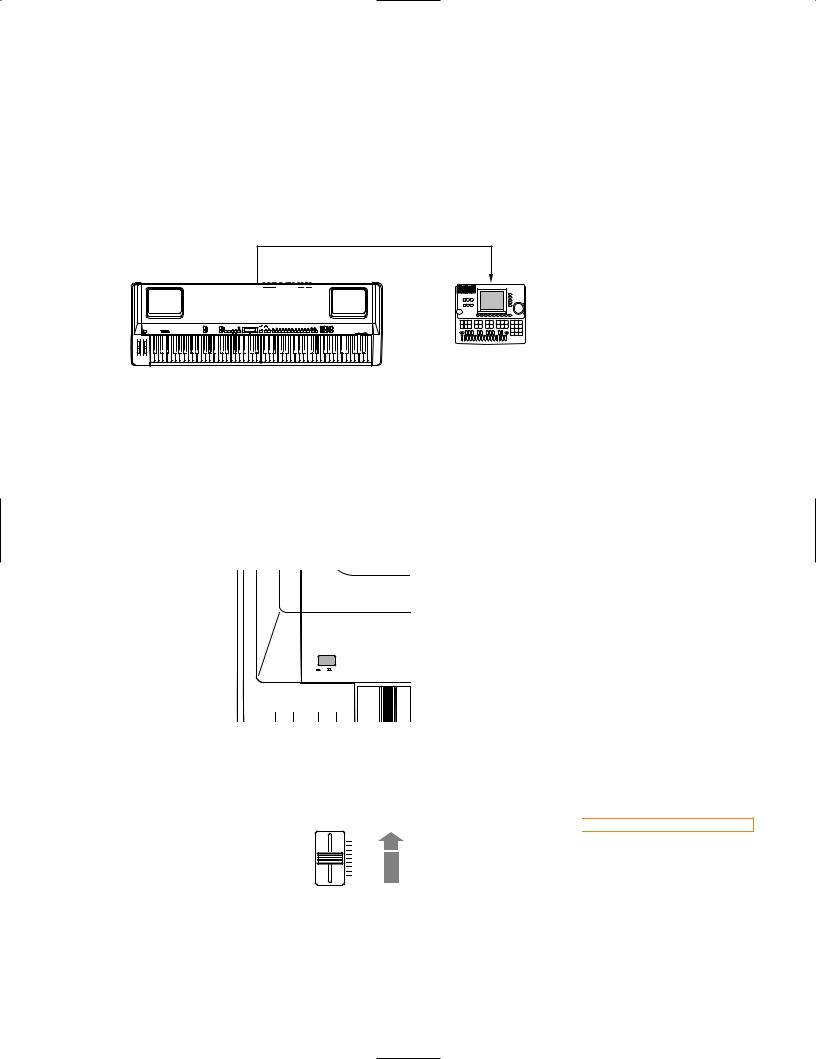
5.Connect MIDI devices.
If you wish to connect the P-200 to external MIDI devices such as a rhythm programmer, tone generator or synthesizer, you will need special MIDI cables which plug into the [MIDI] jacks on the rear panel. First, however, you must determine a MIDI system configuration, based on your particular needs or desires. Some examples of MIDI system connections, along with information about MIDI, are provided on page 64.
|
MIDI Cable |
MIDI OUT |
MIDI IN |
Sequencer
P-200
6. Attach the music stand.
Finally, attach the supplied music stand to the P-200 by carefully inserting it into the slots on the rear panel.
■ Turning on the Power
After setting up the P-200, you’re ready to turn on the power and begin enjoying the instrument’s great sounds and many versatile performance and other features.
POWER
|
ON/ OFF |
PITCH |
MODULATION |
Switch on the [POWER] button, then gradually raise |
[VOLUME] slider until you |
obtain a comfortable listening level. |
|
VOLUME
MAX
MIN
 CAUTION
CAUTION
Always turn the P-200 on first, and then turn on external MIDI and audio devices last. However, if a line-level device is plugged into the P-200’s [INPUT] jacks, turn it on before turning on the P-200. When turning off the power of each device, simply reverse the process.
20

■ Playing the Demo Songs
After setting up the P-200 and turning on the power — and before you begin exploring the instrument’s various features — you may want to listen to the various Demo songs, which have been specially programmed to demonstrate the exceptional sound and performance capabilities of the P-200. There are three main Demo songs, as well as twelve special Voice Demo songs that showcase each voice.
HOW TO PLAY THE DEMO SONGS
1. Enter Demo Play mode.
Press the [REVERB] and [MODULATION] buttons simultaneously. The following screen appears.
EFFECT
REVERB MODULATION
ROOM CHORUS
STAGE SYMPHONIC
HALL TREMOLO
DEMO
Song Select
2.● Selecting and playing a main Demo song:
Immediately after pressing [REVERB] and [MODULATION] (step 1, above), press the [MODULATION] button once or more to select a Demo song. For example, press the button once to select the first Demo song (“Song 1 Play”), or twice to select the second Demo song (“Song 2 Play”), or three times to select the third Demo song (“Song 3 Play”). The song you select will begin playing automatically.
 NOTE
NOTE
If you don’t press the [MODULATION] button (or one of the [VOICE SELECT] buttons) relatively quickly after having entered the Demo Play mode, the P- 200 will automatically exit the Demo Play mode.
EFFECT
REVERB MODULATION
ROOM CHORUS
STAGE SYMPHONIC
HALL TREMOLO
DEMO
Song 1 Play
If you press the [MODULATION] button four times, the message “All Voice Demo” will appear in the LCD screen, and the P-200 will play all twelve voice Demo songs continuously, one after the other.
All Voice Demo
********* Play
Voice name for current Demo song
21
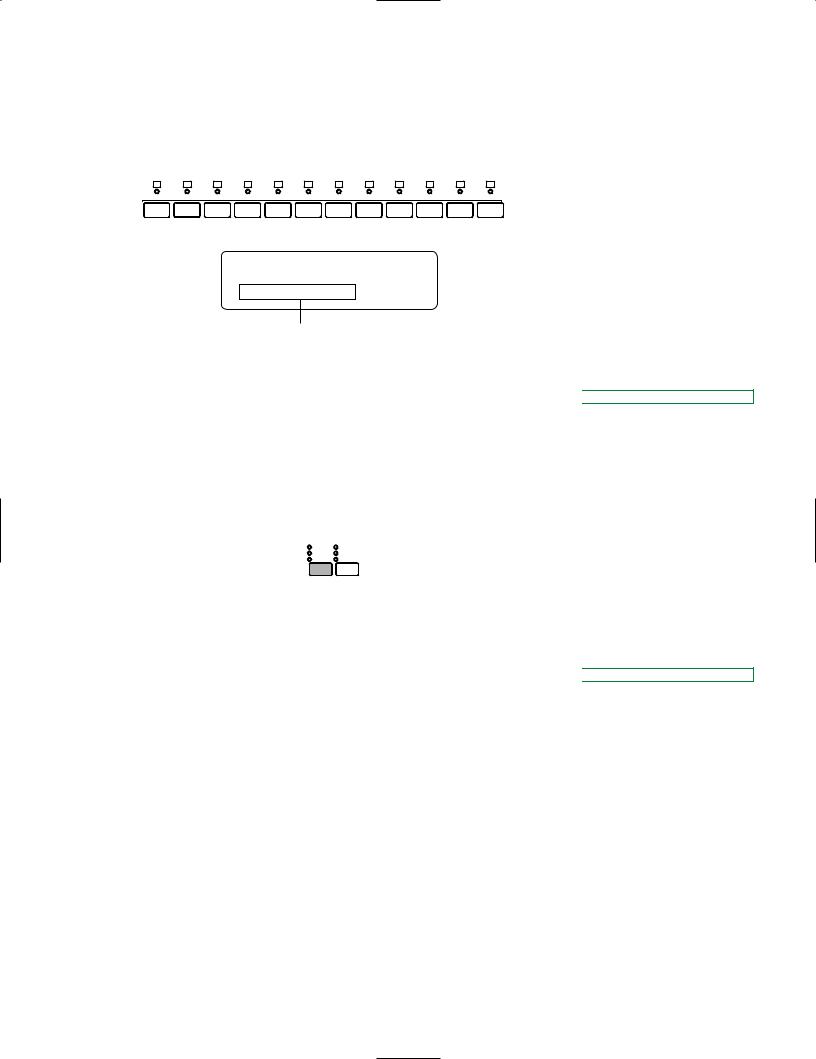
● Selecting and playing a Voice Demo song:
Immediately after pressing [REVERB] and [MODULATION] (step 1, above), press the [VOICE SELECT] button corresponding to the desired voice. The selected song will begin playing automatically.
1 |
2 |
3 |
4 |
5 |
6 |
7 |
8 |
9 |
10 |
11 |
12 |
PIANO 1 |
PIANO 2 |
PIANO 3 |
PIANO 4 |
E.PIANO 1 |
E.PIANO 2 |
E.PIANO 3 |
VIBES |
ORGAN 1 |
ORGAN 2 |
STRINGS |
BASS |
SYSTEM |
MIDI FILTER |
PC TABLE |
CHANNEL |
LOCAL |
CS FC |
PS |
NAME |
ORGAN |
PB MW |
KBD SENS. |
INT.EQ |
|
|
|
|
|
|
|
|
COMBINATION |
|
|
|
DEMO
********* Play
Voice name for current Demo song
3.Exit Demo Play mode.
If you select “Song 1 Play”, “Song 2 Play”, “Song 3 Play” or “All Voice Demo,” the P-200 will exit the Demo Play mode automatically when the selected song finishes playing.
To exit Demo Play mode while a song is playing, simply press the [REVERB] button.
EFFECT
REVERB MODULATION
ROOM CHORUS
STAGE SYMPHONIC
HALL TREMOLO
■ Playing the Voices
Selecting and playing the voices of a new P-200 is simple, since by default the instrument starts up for the first time in Voice Play mode with initialized parameter settings, and the PIANO 1 voice selected.
Therefore, all you have to do is press a [VOICE SELECT] button and start playing the keyboard. Take a few minutes and try playing each of the voices and notice the rich quality and dimension of the P-200’s AWM sound, complete with the nuance of natural expression via the keyboard.
As you play, try out the [PITCH] wheel, which lets you bend notes up or down. Also try out the [MODULATION] wheel, which lets you add varying degrees of vibrato (or other effects) to the voices.
While you’re at it, try out the various reverb and modulation effects, by pressing the [REVERB] and [MODULATION] buttons once or more.
When you’re ready for more, turn the page, and find out about all the P-200 has in store.
 NOTE
NOTE
You cannot enter Demo Play mode (or any other Play mode) when the P-200 is in Edit mode. (The LED above the [EDIT] button will blink when the P-200 is in Edit mode.) To exit Edit mode, simply press the [EDIT] button. Also note that you will not be able to play the P-200 or use any of the Edit mode functions while a Demo song is playing.
 NOTE
NOTE
You can assign a specific effect to the [MODULATION] wheel in Edit mode (see page 58) which is completely unrelated to the modulation effects available by pressing the [MODULATION] button (see page 27) once or more. Note that when the vibrato effect is assigned to the [MODULATION] wheel, you cannot apply vibrato modulation to the Piano voices 1 ~ 4. Also note that the reverb depth or modulation speed may be set at 0 for certain voices, and therefore produce no noticeable effect. (For information about changing reverb depth, see page 27. For information about changing modulation speed, see page 28.)
22
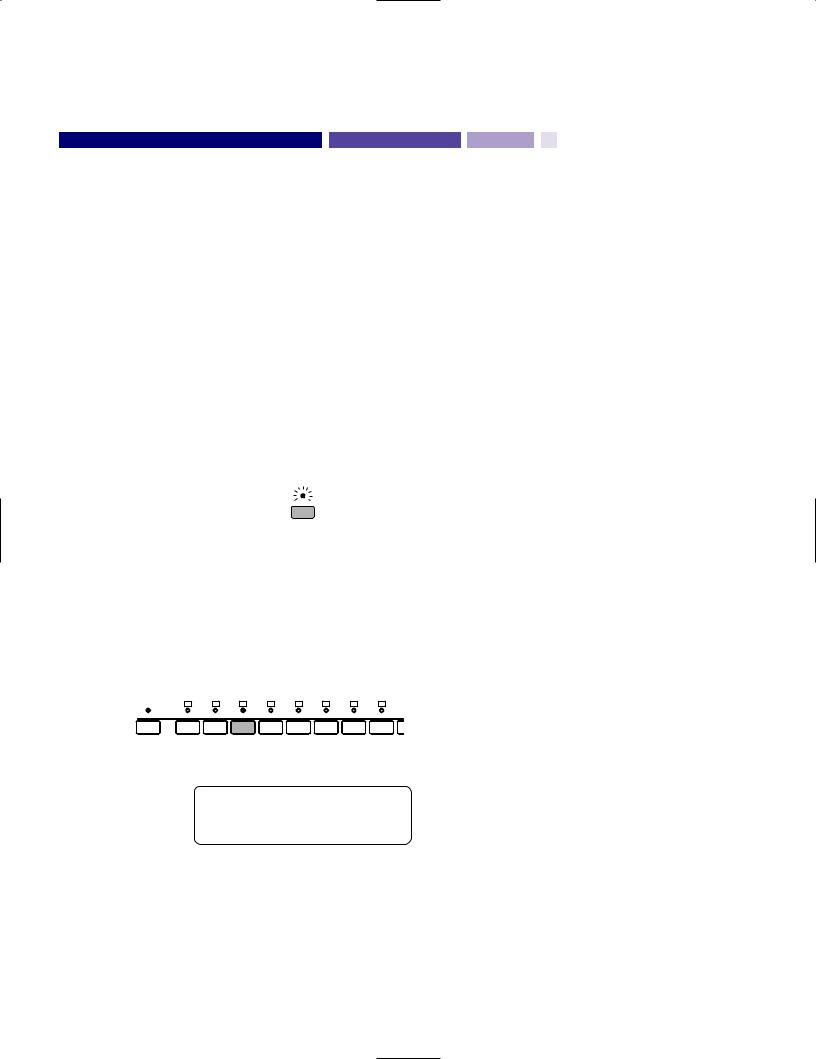
VOICE PLAY MODE
Voice Play mode consists of Single, Dual and Split modes. Within Voice Play mode you can select and play any one of the 12 voices (Single mode), or play a blend of two voices simultaneously (Dual mode), or play one voice on the left side of the keyboard and another on the right side of the keyboard (Split mode).
A brand new P-200 fresh out of the box will power on automatically in Voice Play Single mode, with the PIANO 1 voice selected.
If the P-200 is in Performance Play mode (indicated by a lit LED above the [PERF.A] or [PERF.B] button), you will first need to press the [VOICE] button to enter Voice Play mode.
If the P-200 is in Edit mode (indicated by a blinking LED above the [EDIT] button), you will first need to exit Edit mode by pressing the [EDIT] button.
ENTERING AND EXITING VOICE PLAY MODE
1. Press the [VOICE] button.
When you press the [VOICE] button while the P-200 is in Performance Play mode, the LED above the [VOICE] button starts blinking, indicating that Voice Play mode is standing by waiting to be activated.
VOICE
2.Press a [VOICE SELECT] button.
As soon as a [VOICE SELECT] button is pressed, Voice Play Single mode is activated.
The LED above the [VOICE] button and the selected [VOICE SELECT] button will light.
|
1 |
2 |
3 |
4 |
5 |
6 |
7 |
8 |
|
VOICE |
PIANO 1 |
PIANO 2 |
PIANO 3 |
PIANO 4 |
E.PIANO 1 |
E.PIANO 2 |
E.PIANO 3 |
VIBES |
OR |
|
SYSTEM |
MIDI FILTER |
PC TABLE |
CHANNEL |
LOCAL |
CS FC |
PS |
NAME |
O |
|
|
|
|
|
|
|
|
|
COM |
9ï VOICE 9ñ Piano 3
From within Single mode you can easily activate Dual mode (see page 30) or Split mode (see page 32).
To exit Voice Play mode, simply enter Performance Play mode. For details, see page 45.
23
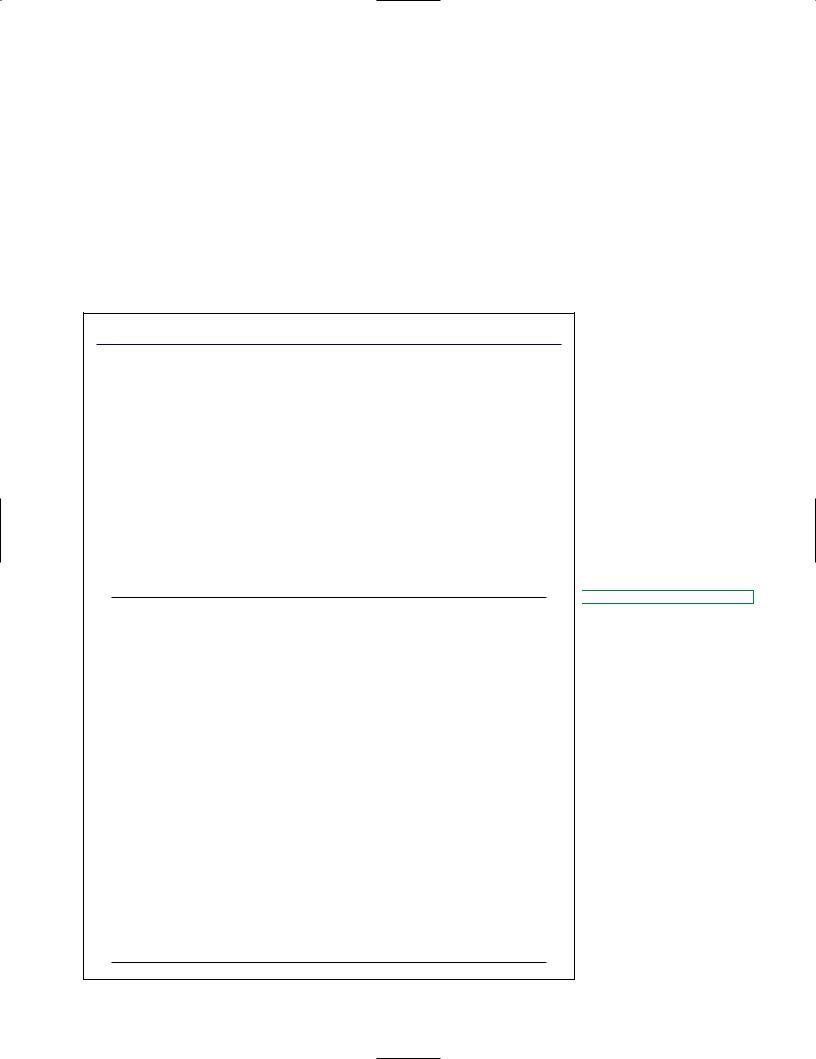
■ Single Mode
When the P-200 is in Single mode, you can select and play any one of the 12 voices over the full range of the keyboard. You can also apply and adjust reverb and modulation effects, and adjust the graphic equalizer settings.
In Single mode, the LED above the currently selected [VOICE SELECT] button lights, and the name of the currently selected Single voice appears in the LCD screen.
SELECTING A SINGLE VOICE
Press a [VOICE SELECT] button.
To select a voice you need only press any of the 12 [VOICE SELECT] buttons.
Voices and Polyphony
The P-200’s voices are high quality samples of real musical instruments generated by Yamaha’s exclusive AWM (Advanced Wave Memory) tone generation process.
All of the voices have 64-note polyphony, which means that a maximum number of 64 notes can be played simultaneously. This is crucial for achieving uncompromising sound and performance when using a sustain pedal, where certain notes must hold over others as you play, until you release the sustain pedal.
There is an extra dimension to some of the P-200’s voices. Two of the PIANO voices have special stereo settings, which are capable of 32-note polyphonic output. Also, the BASS voice has both acoustic UPRIGHT BASS and ELECTRIC BASS settings.
The following table provides an overview of each preset AWM voice.
NO. |
VOICE |
DESCRIPTION |
SAMPLE TYPE |
POLYPHONY |
||
1 |
PIANO 1 |
Acoustic grand piano, suitable |
Mono / Stereo |
64 |
/ 32 |
|
for various types of music, |
||||||
|
|
from classical to jazz. |
|
|
|
|
|
|
|
|
|
|
|
2 |
PIANO 2 |
Acoustic grand piano, with |
Mono / Stereo |
64 |
/ 32 |
|
sophisticated and deeper |
||||||
|
|
resonance and body. |
|
|
|
|
3 |
PIANO 3 |
Bright acoustic grand piano, |
Mono |
64 |
|
|
ideal for rock as well as jazz. |
|
|||||
|
|
|
|
|
||
4 |
PIANO 4 |
Bright electric grand piano, |
Mono |
64 |
|
|
ideal for pop ballads. |
|
|||||
|
|
|
|
|
||
5 |
E. PIANO 1 |
Standard electric piano |
Mono |
64 |
|
|
with a sharp attack sound. |
|
|||||
|
|
|
|
|
||
6 |
E. PIANO 2 |
Conventional, all-purpose |
Mono |
64 |
|
|
electric piano sound. |
|
|||||
|
|
|
|
|
||
7 |
E. PIANO 3 |
Bright and sparkling, |
Mono |
64 |
|
|
DX-type electric piano sound. |
|
|||||
|
|
|
|
|
||
8 |
VIBES |
Full-bodied vibraphones |
Mono |
32 |
(2 layered) |
|
with sharp attack. |
||||||
|
|
|
|
|
||
9 |
ORGAN 1 |
Full-set organ combination sound |
Mono |
16 |
|
|
with editable footage lengths |
|
|||||
|
|
and other parameters. |
|
|
|
|
|
|
|
|
|
|
|
10 |
ORGAN 2 |
Standard jazz organ sound. |
Mono |
64 |
|
|
11 |
STRINGS |
Full orchestral string ensemble. |
Mono |
64 |
|
|
12 |
BASS |
Full-bodied, resonating |
Mono |
64 |
|
|
Upright Bass, and deep |
|
|||||
Electric Bass with punch.
 NOTE
NOTE
The Organ 1 voice can be edited and reconfigured in Edit mode (see page 57).
24
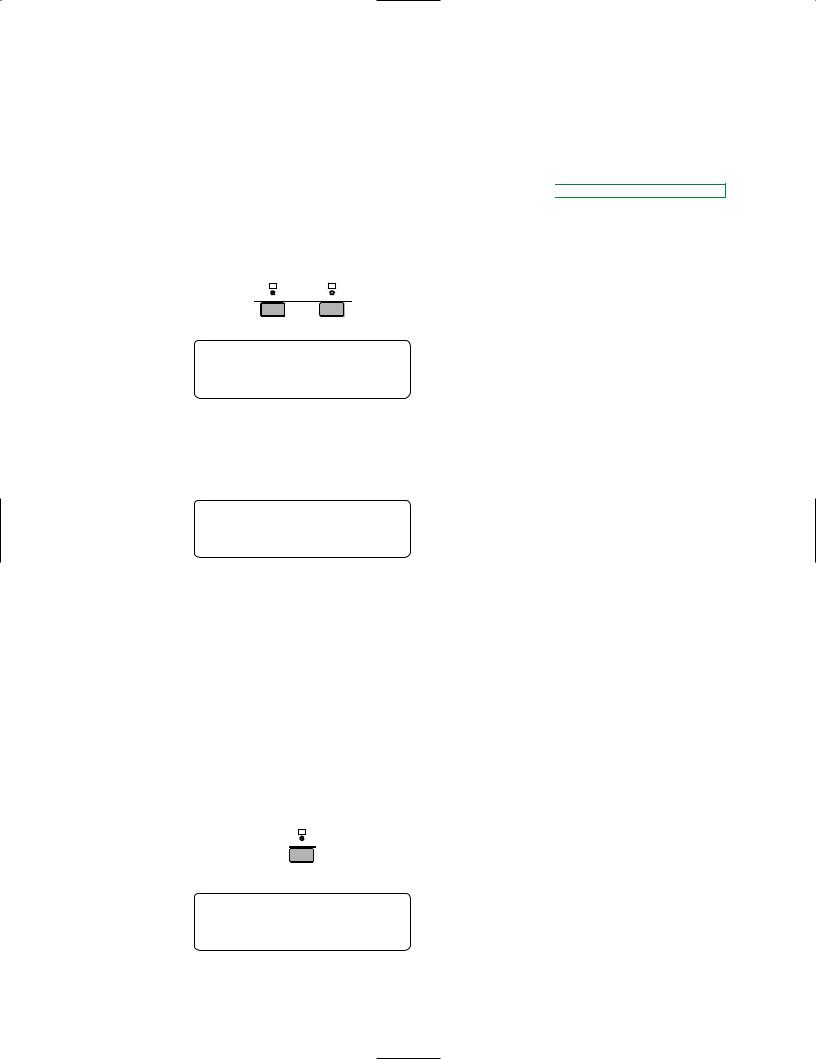
■ Stereo/Mono Piano
Pressing and holding the [PIANO 1] (or [PIANO 2]) button for a few moments alternately selects the stereo and mono settings.
The initial default setting for the PIANO 1 (and PIANO 2) voice is stereo, and polyphony is 32 notes.
CHANGING THE PIANO VOICE SETTING
Press and hold [PIANO 1] (or [PIANO 2]) for a few moments.
After a moment, the MONO screen briefly appears.
1 |
2 |
PIANO 1 |
PIANO 2 |
|
or |
SYSTEM |
MIDI FILTER |
Piano1 32/64 $ mono
As you play the keyboard, the output of the PIANO 1 voice will be in mono, and polyphony will be 64 notes.
To return the PIANO 1 voice to its stereo setting, simply press and hold [PIANO 1] for a few moments again. The STEREO screen briefly appears.
Piano1 32/64 $ stereo
■ Upright/Electric Bass
Pressing and holding the [BASS] button for a few moments alternately selects the Upright and Electric settings.
The initial default setting for the BASS voice is Upright Bass.
 NOTE
NOTE
Once you have modified certain parameters in Voice Play or Performance Play mode, $ (Quick Edit) will display in the upper right corner to remind you that you have modified the original settings. Parameters include the following: reverb and modulation setting, stereo/mono setting for Piano1 and Piano2, electric/upright setting for Bass, plus Balance, Dual Detune, Split, and Transpose settings.
CHANGING THE BASS VOICE SETTING
Press and hold [BASS] for a few moments.
After a moment, the ELECTRIC BASS screen briefly appears.
12
BASS
INT.EQ
Upright/Elec. $ Elec.Bass
25
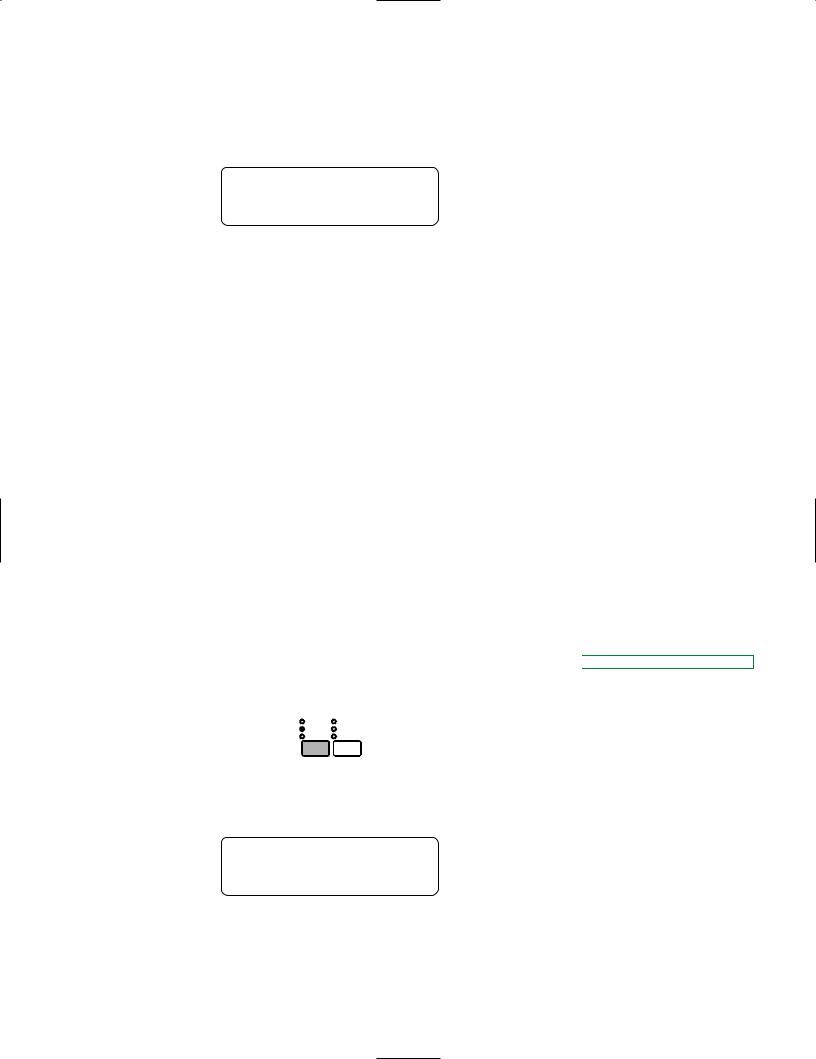
As you play the keyboard, you will hear the Electric Bass voice.
To change back to the UPRIGHT BASS voice, simply press and hold [BASS] for a few moments again. The UPRIGHT BASS screen briefly appears.
Upright/Elec. $ Upright Bass
■ Reverb Effects
The P-200’s internal DSP digital signal processor generates three types of realistic reverb effects, or simulated ambient environments, which you can apply to the voices.
These include ROOM, which simulates the natural reverberations of sound in a normal-sized room, STAGE, which simulates the natural reverberations of sound in a night club, and HALL, which simulates the natural reverberations of sound in a relatively large concert hall.
As you select each voice you will notice that a specific reverb effect is already assigned to it, indicated by a lit LED to the left of the name of the selected reverb type. These are the initial default assignments set at the factory, but you can select any reverb effect you wish for each voice, or even turn the reverb effect off. You can also change reverb depth on the spot.
SELECTING A REVERB TYPE
Press the [REVERB] button once or more.
When you press the [REVERB] button repeatedly, the reverb types will be selected in order as follows: ROOM, STAGE, HALL, then OFF. (No lit LED represents Off status.)
EFFECT
REVERB MODULATION
ROOM  CHORUS
CHORUS
STAGE SYMPHONIC
HALL TREMOLO
 NOTE
NOTE
You can also select the reverb type and depth settings in Edit mode (see page 59).
Note that each time you select a reverb type, a message will briefly display in the LCD screen, as follows.
REVERB DEPTH $ 2Ä€
This temporary message displays the current depth level for the reverb type that you just selected, between 0 and 7.
You can easily change the depth level for the currently selected reverb type.
26
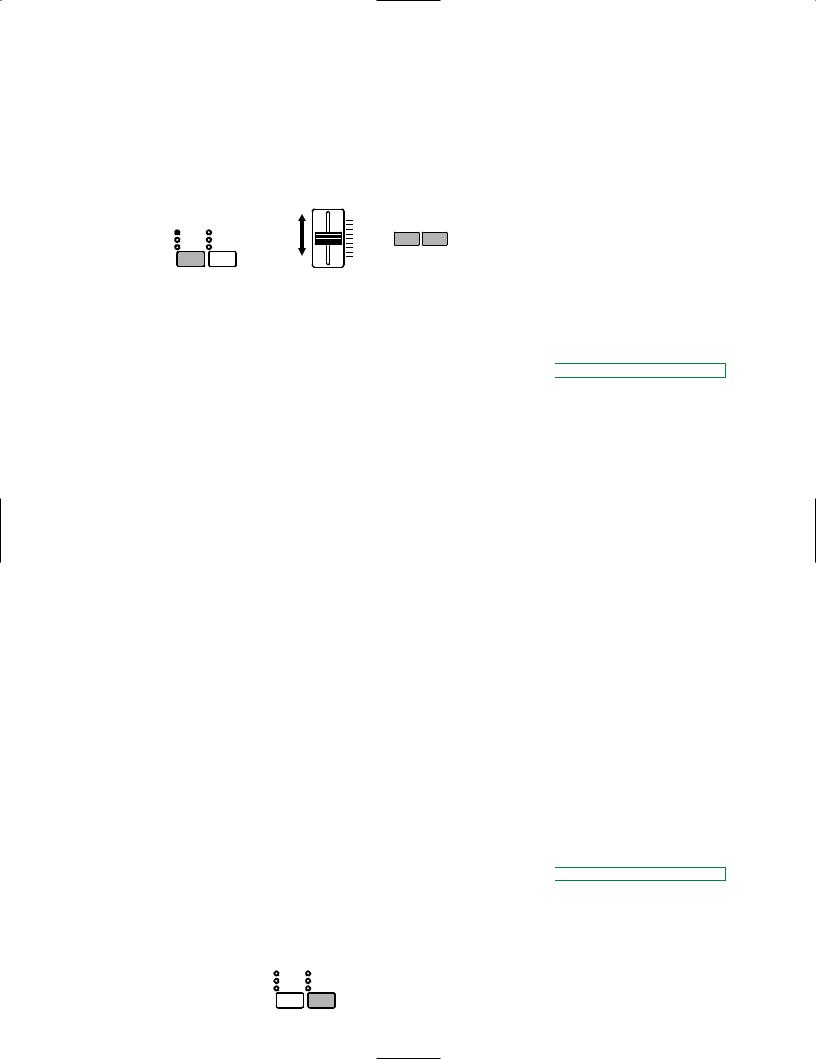
CHANGING REVERB DEPTH
1. Hold the [REVERB] button and move the [DATA ENTRY] slider (or press
[–1/NO] or [+1/YES]).
As soon as you move the [DATA ENTRY] slider (or press [–1/NO] or [+1/YES]) the REVERB DEPTH screen appears.
EFFECT |
|
CS |
|
||
|
|
|
|
||
REVERB |
MODULATION |
+ |
PS1 |
PS2 |
|
ROOM |
CHORUS |
||||
or |
|
||||
STAGE |
SYMPHONIC |
|
|||
HALL |
TREMOLO |
|
|
||
|
|
|
-1/NO |
+1/YES |
|
DATA ENTRY
If you move the [DATA ENTRY] slider upward, the depth level increases; if you move the [DATA ENTRY] slider downward, the depth level decreases.
A value of 7 will produce the largest number of reverberations, whereas a value of 0 will effectively turn the reverb off.
2.Release the [REVERB] button.
After a moment, the voice name will reappear in the screen.
Try different settings and play the keyboard and notice the difference between high and low reverb depth level settings, and the P-200’s wide variety of reverb options.
 NOTE
NOTE
In Voice Play mode, a different reverb type and depth can be selected for each voice. When you play two voices in either Dual or Split mode, the P-200 will apply the main voice reverb type and depth setting to both voices, and ignore any settings which you may have made for the sub voice. For more information about main and sub voices, see page 29.
■ Modulation Effects
The P-200’s internal DSP digital signal processor generates three types of modulation effects which you can apply to the voices. (Note: These modulation effects are unrelated to the vibrato effect which you can apply to voices using the [MODULATION] wheel. For details about the vibrato effect, see page 59.)
These include CHORUS, a modulated delay which effectively makes a voice sound like more than one instrument is being played, SYMPHONIC, a more pronounced chorus effect, and TREMOLO, a rotating speaker effect.
As you select each voice you will notice that most have a specific modulation effect already assigned to them, indicated by a lit LED to the left of the name of the selected modulation effect type. These are the initial default assignments set at the factory, but you can select any modulation effect you wish for each voice, or even turn the modulation effect off. You can also change modulation speed on the spot.
SELECTING A MODULATION TYPE
Press the [MODULATION] button once or more.
When you press the [MODULATION] button repeatedly, the modulation types will be selected in order as follows: CHORUS, SYMPHONIC, TREMOLO, then OFF. (No lit LED represents Off status.)
EFFECT
REVERB MODULATION
ROOM CHORUS
STAGE  SYMPHONIC
SYMPHONIC
HALL TREMOLO
 NOTE
NOTE
You can also select the modulation type and speed settings in Edit mode (see page 59).
27
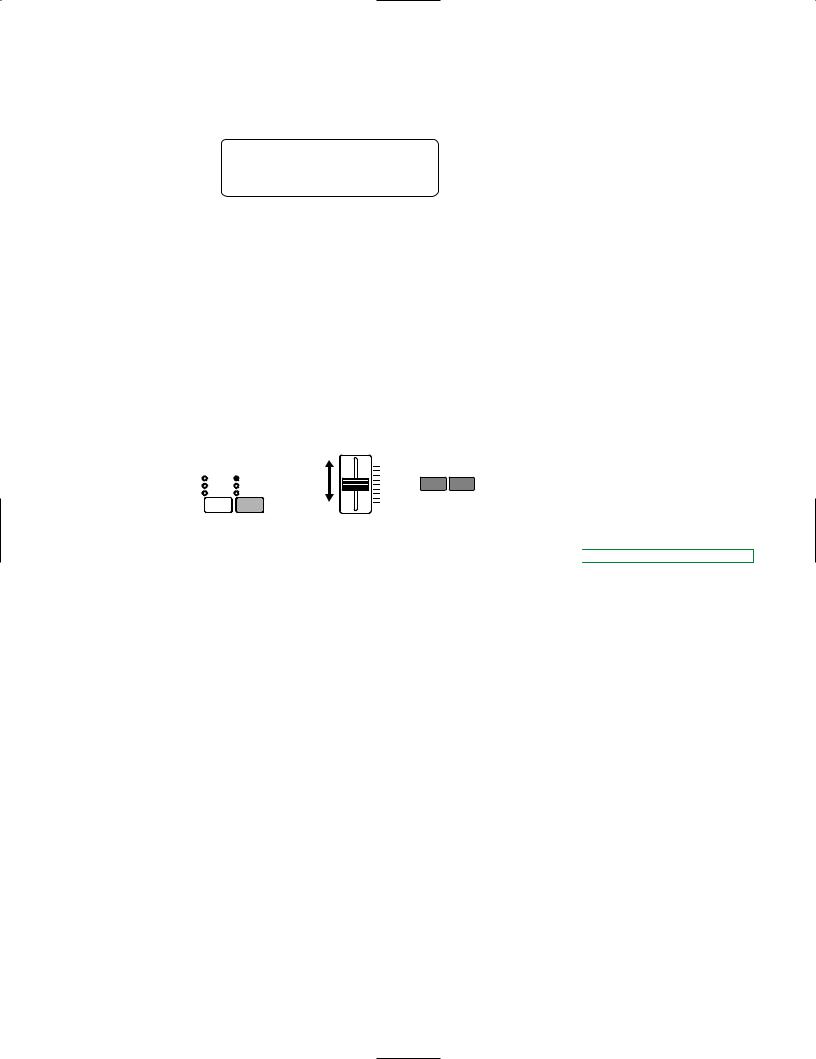
Note that each time you select a modulation type, a message will briefly display in the LCD screen, as follows.
MOD SPEED $ 3à
This temporary message displays the current speed level for the modulation type that you just selected, between 0 and 7. You can easily change the speed level for the currently selected modulation type.
CHANGING MODULATION SPEED
1. Hold the [MODULATION] button and move the [DATA ENTRY] slider (or press [–1/NO] or [+1/YES]).
As soon as you move the [DATA ENTRY] slider (or press [–1/NO] or [+1/YES]) the MODULATION SPEED screen appears.
EFFECT |
|
CS |
|
||
|
|
|
|
||
REVERB |
MODULATION |
+ |
PS1 |
PS2 |
|
ROOM |
CHORUS |
||||
or |
|
||||
STAGE |
SYMPHONIC |
|
|||
HALL |
TREMOLO |
|
|
||
|
|
|
-1/NO |
+1/YES |
|
DATA ENTRY
If you move the [DATA ENTRY] slider upward, the speed level increases; if you move the [DATA ENTRY] slider downward, the speed level decreases. A value of 7 will produce the largest number of modulations, whereas a value of 0 will effectively turn the modulation off.
2.Release the [MODULATION] button.
After a moment, the voice name will reappear in the screen.
Try different settings and play the keyboard and notice the difference between high and low modulation speed level settings.
 NOTE
NOTE
A different modulation type and speed can be selected for each voice. When you play two voices in either Dual or Split mode, the P-200 will apply the main voice modulation type and speed setting to both voices, and ignore any settings which you may have made for the sub voice. For more information about main and sub voices, see page 29.
28
